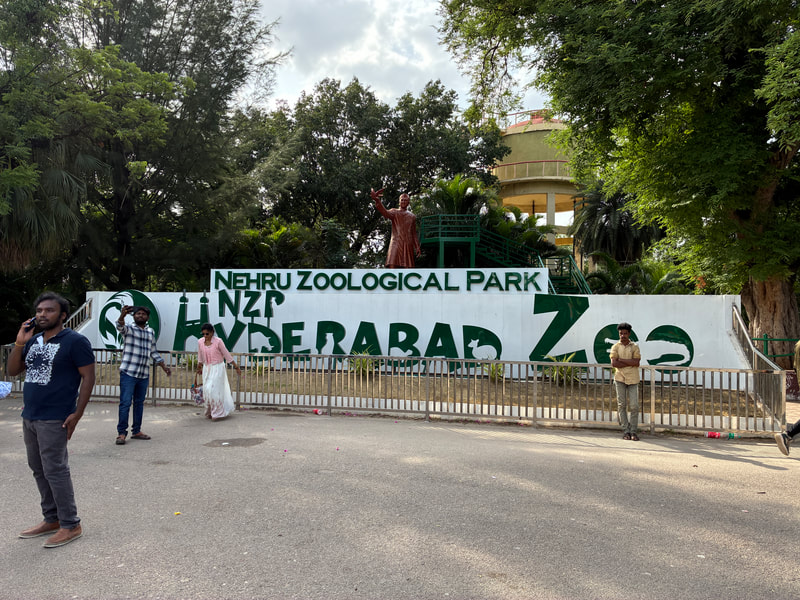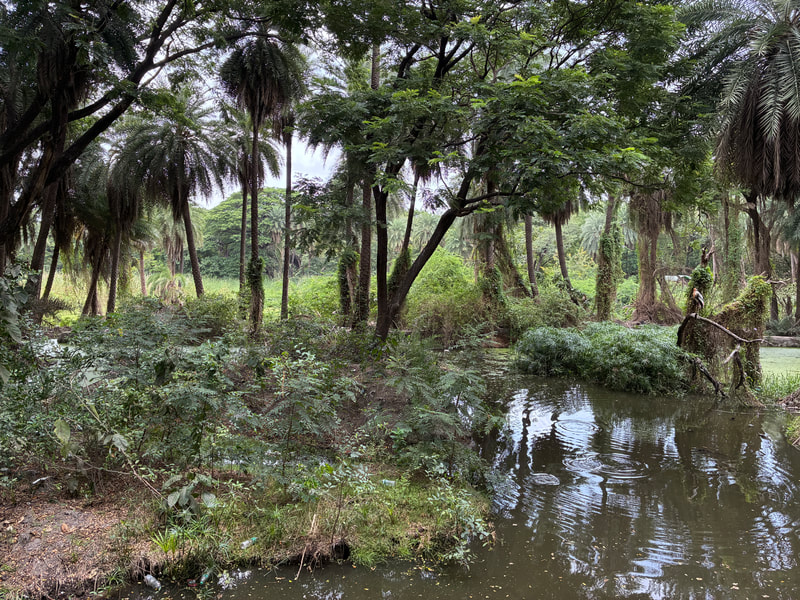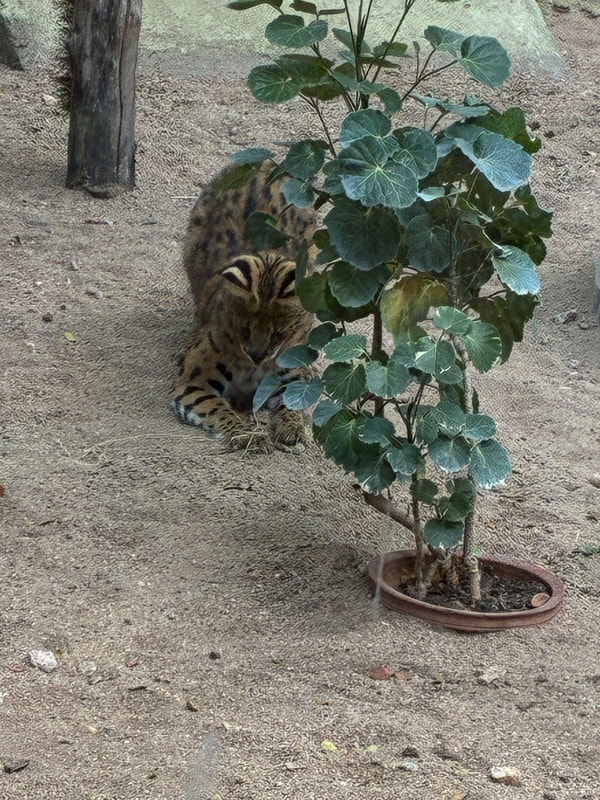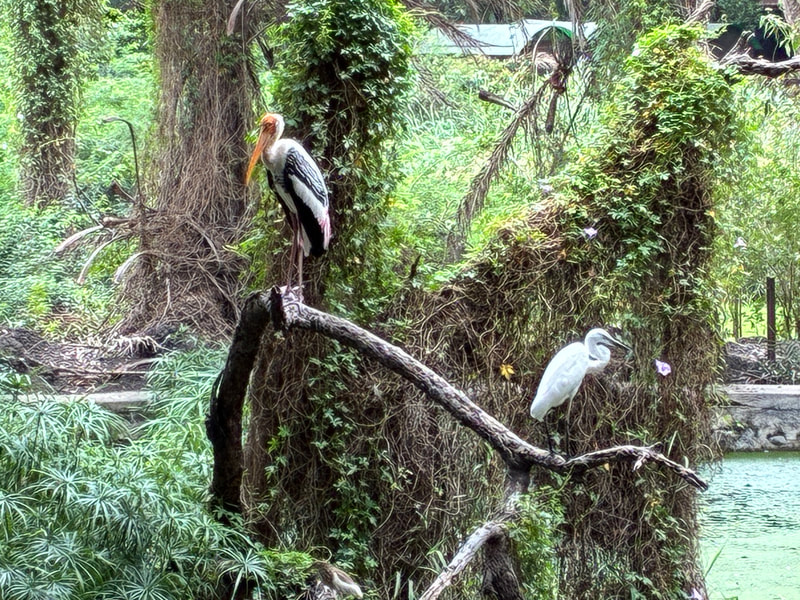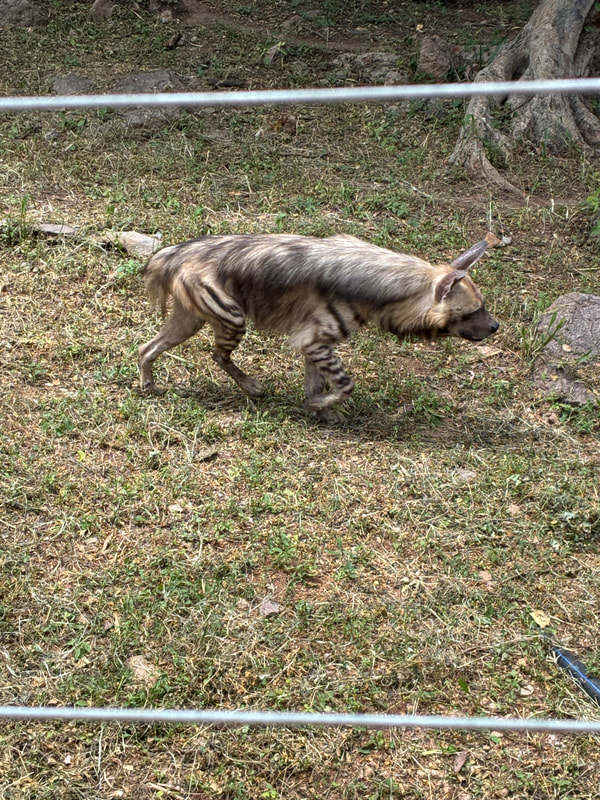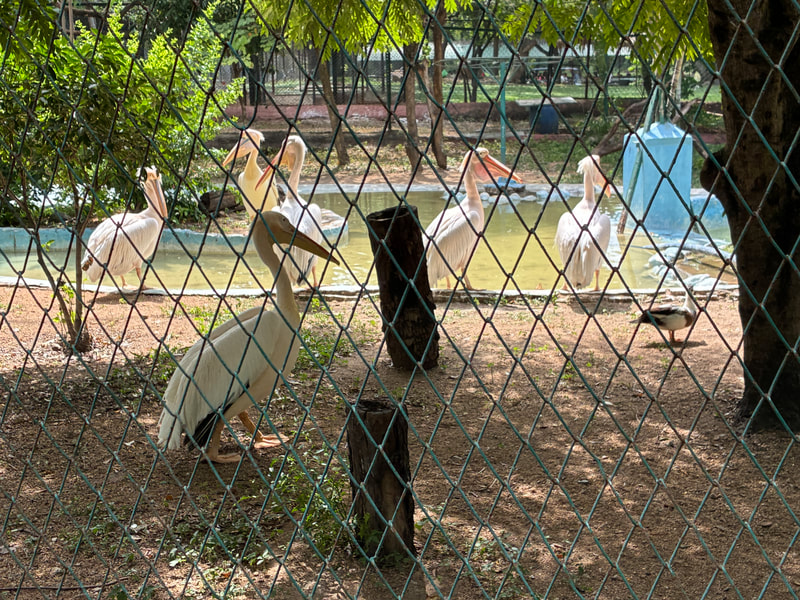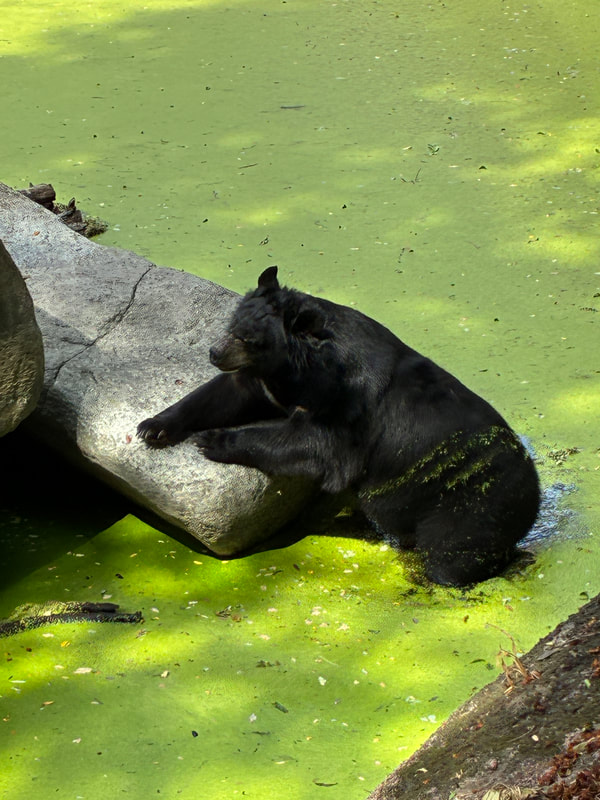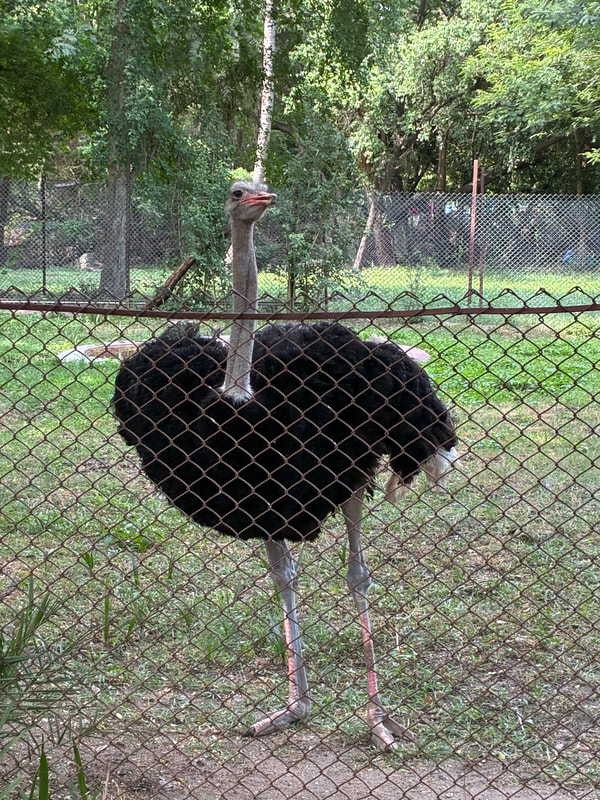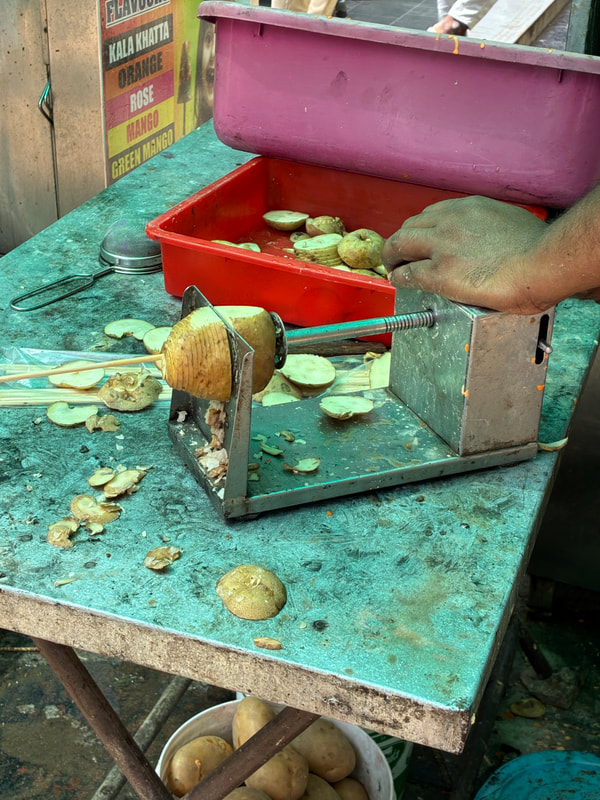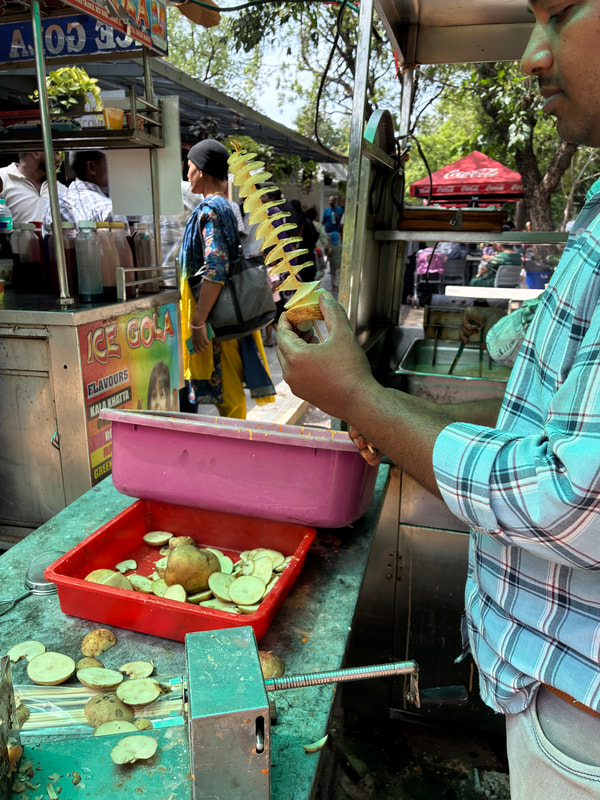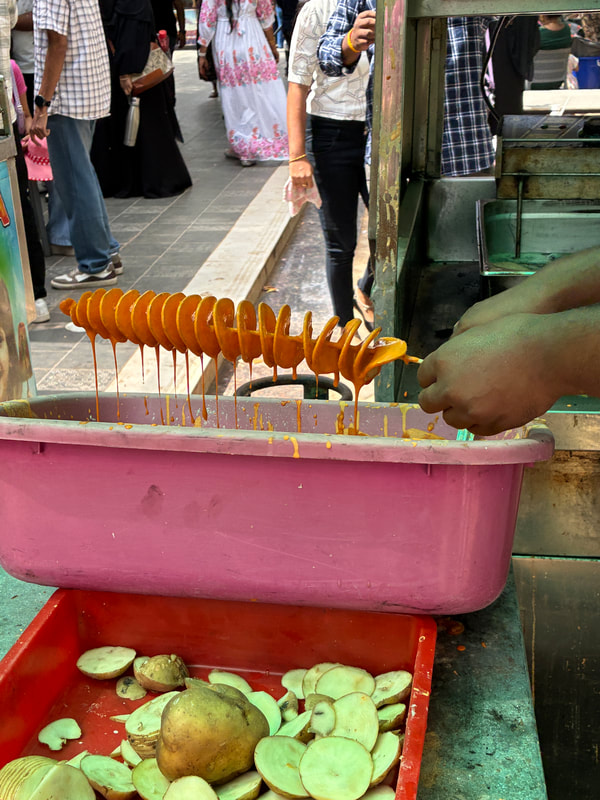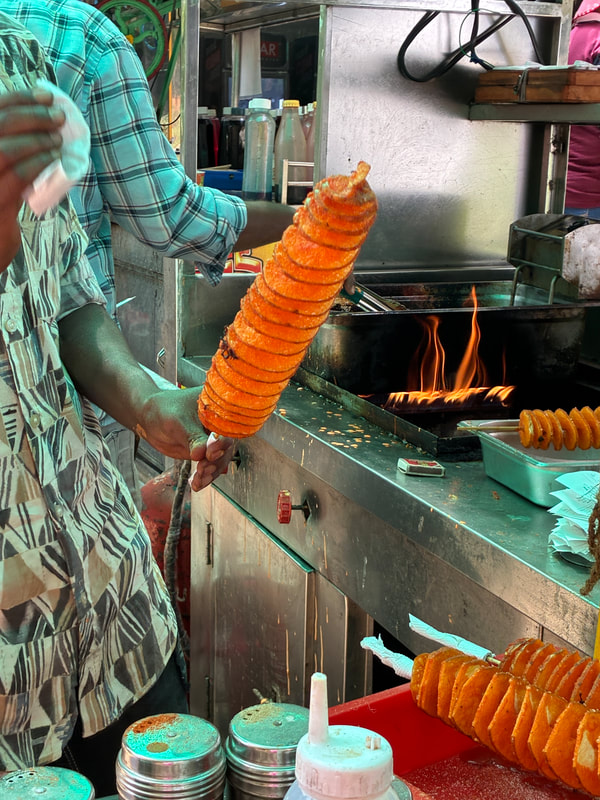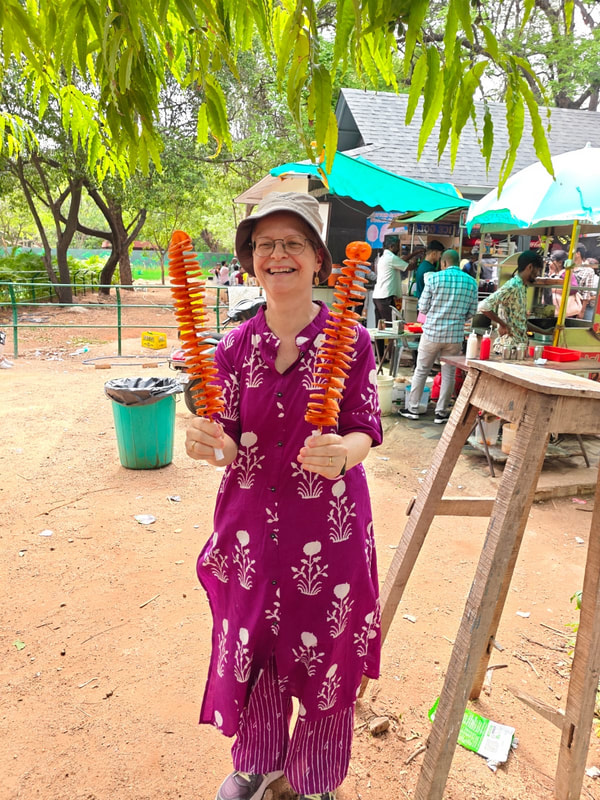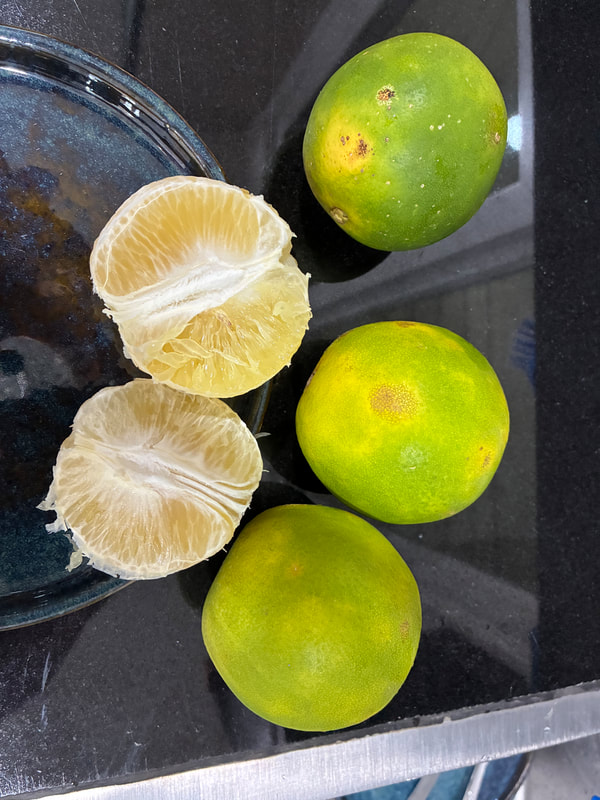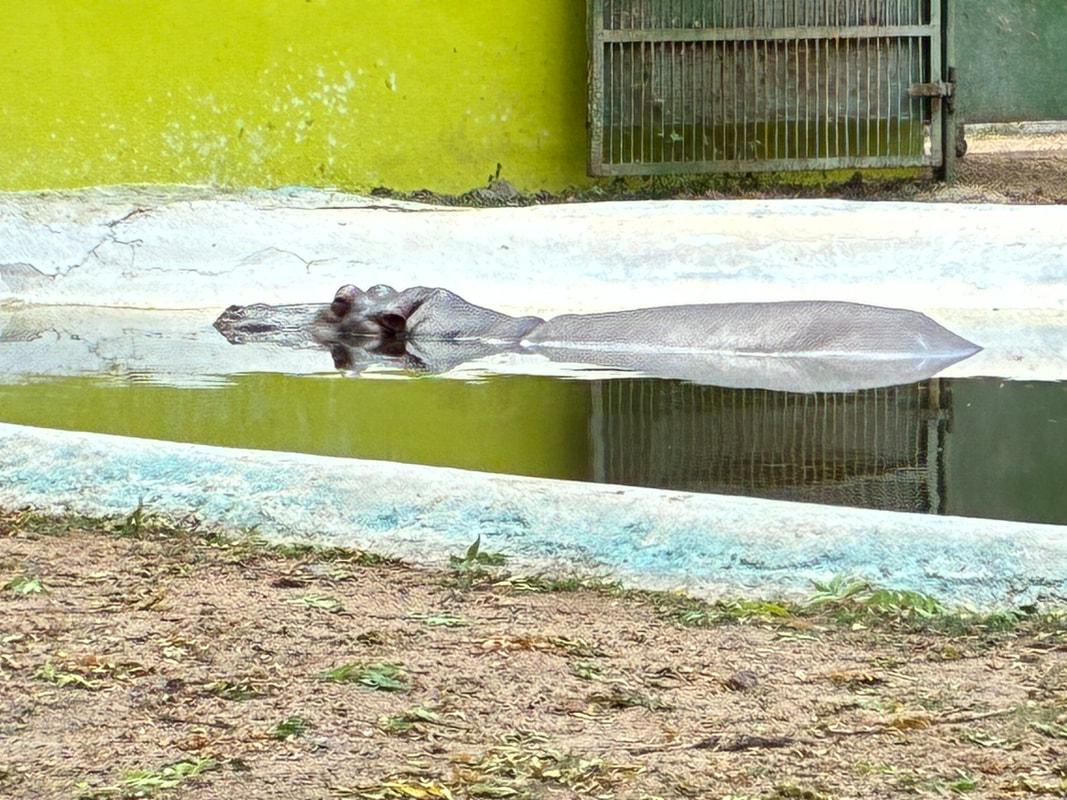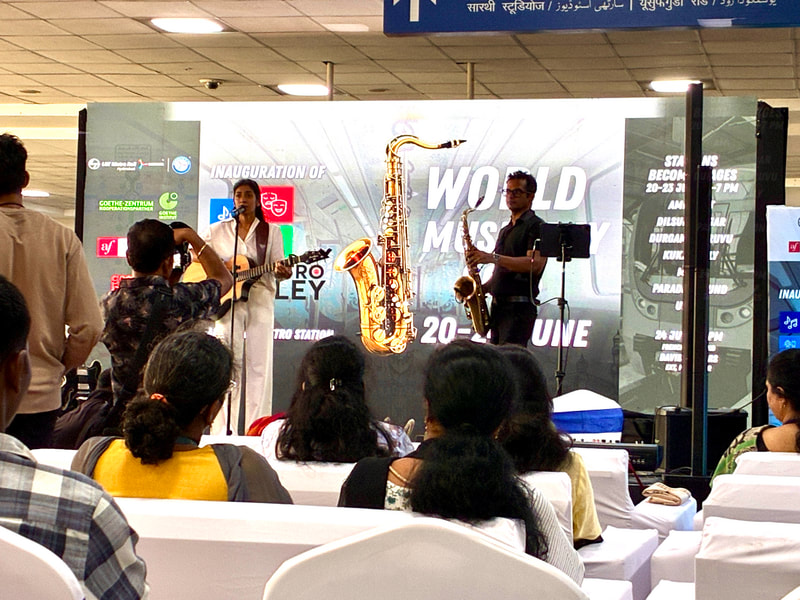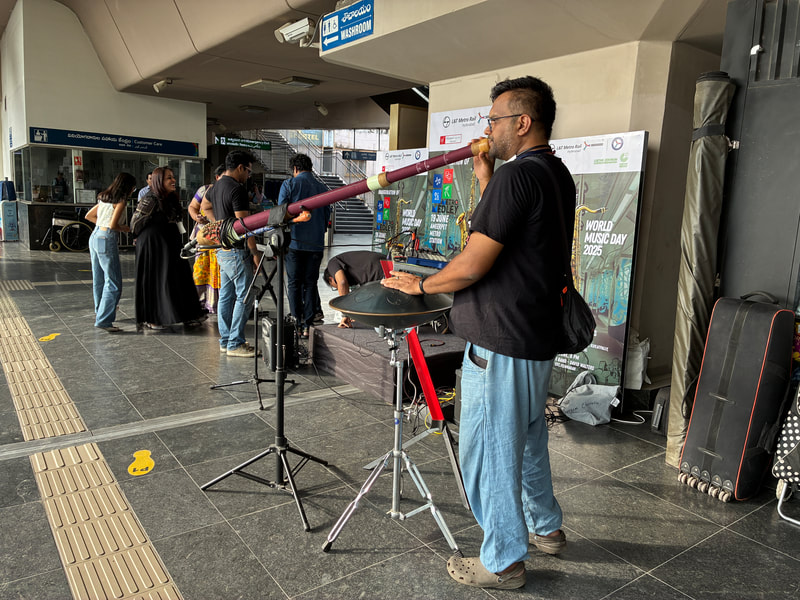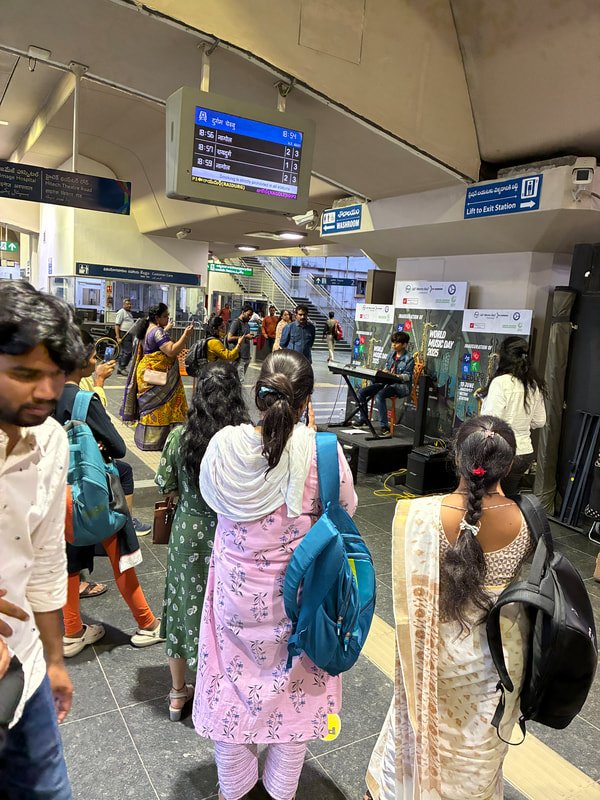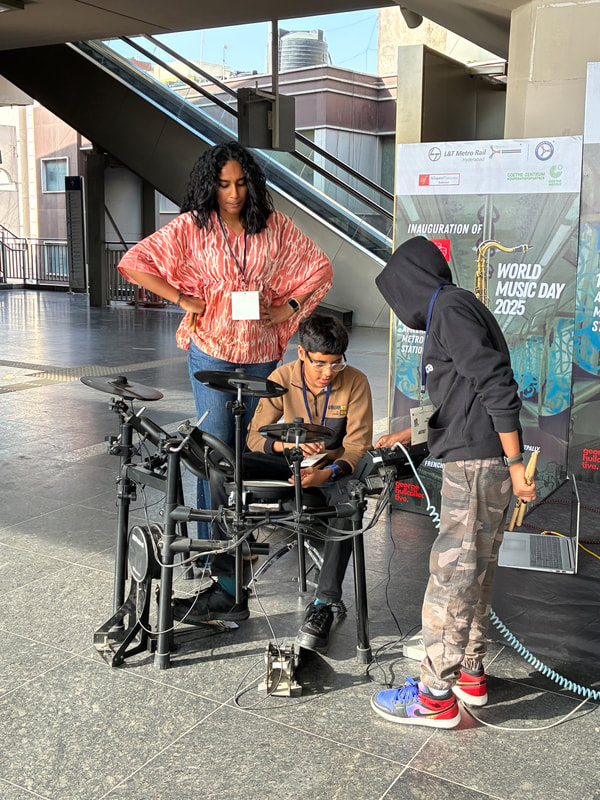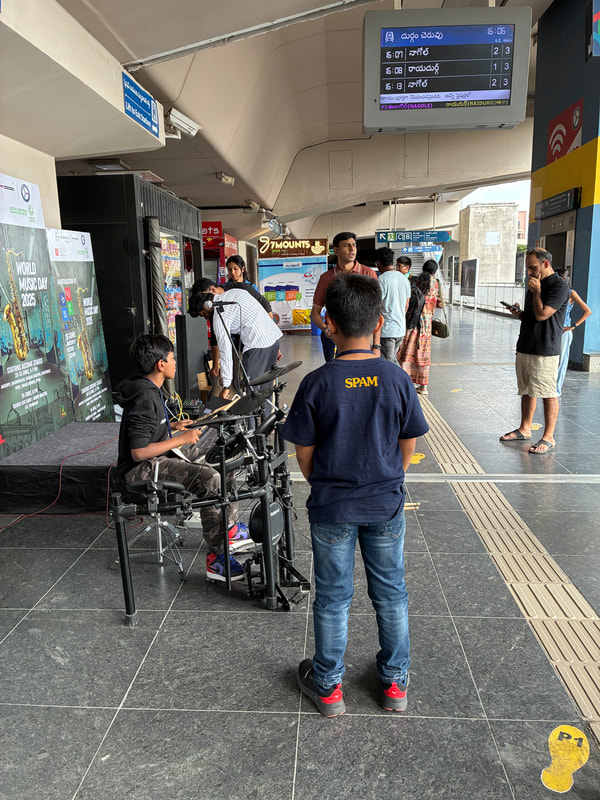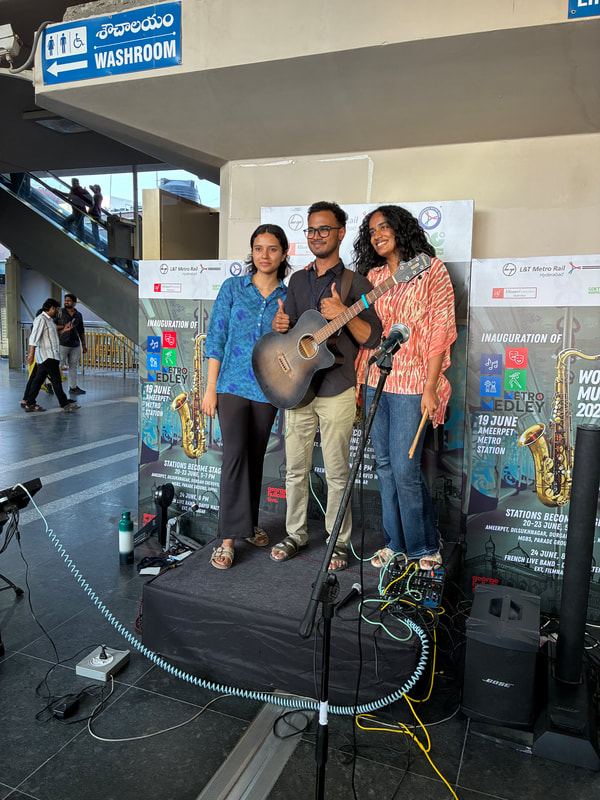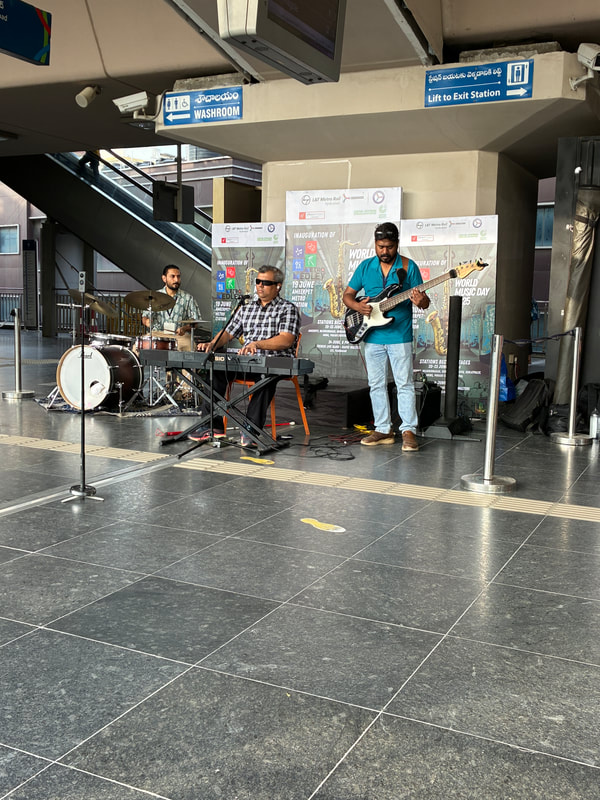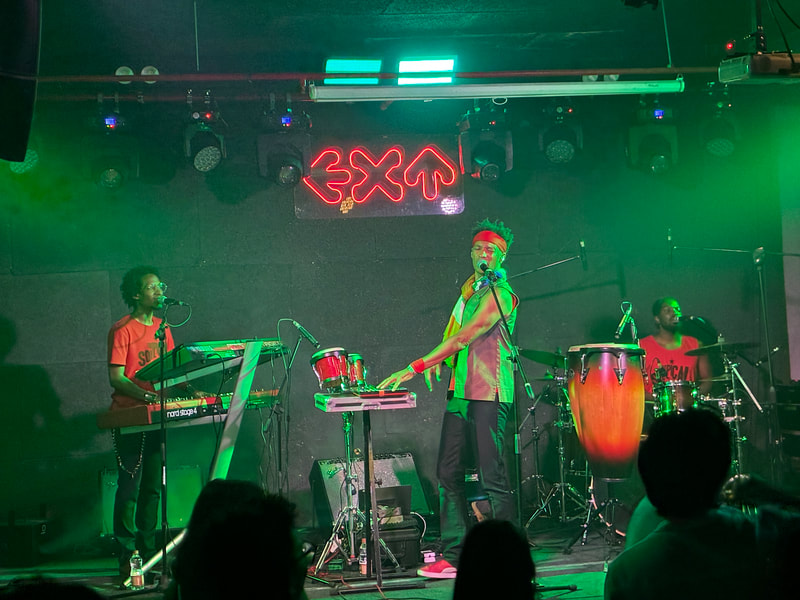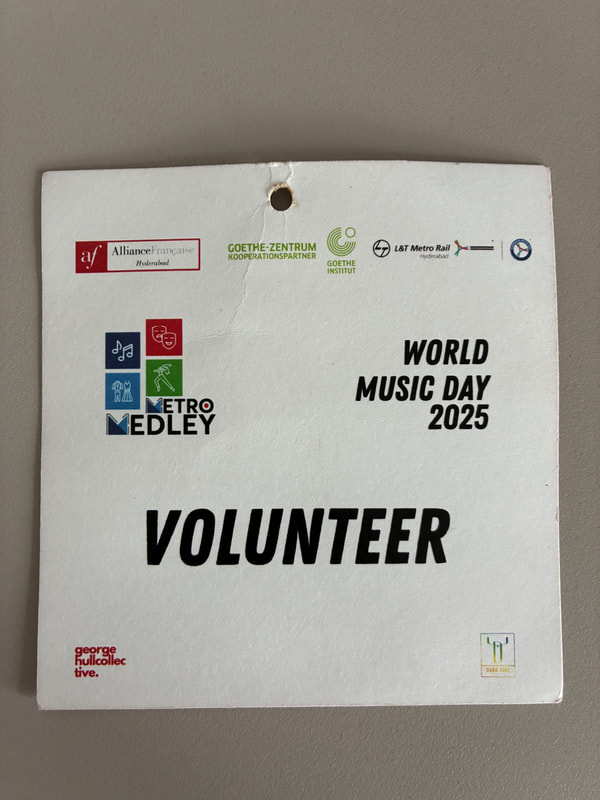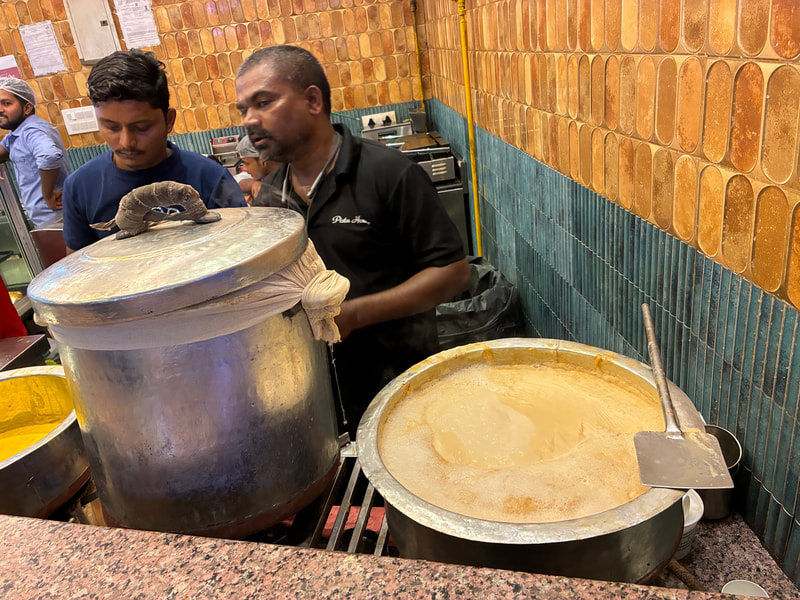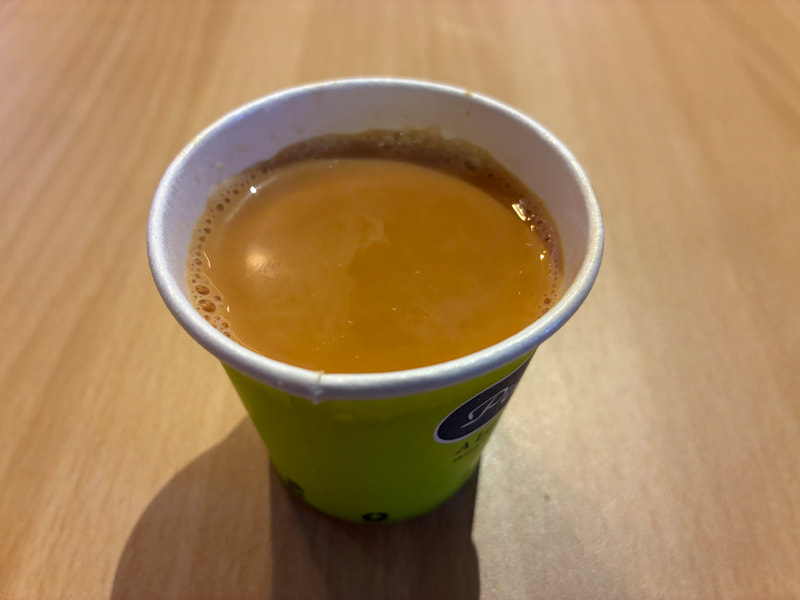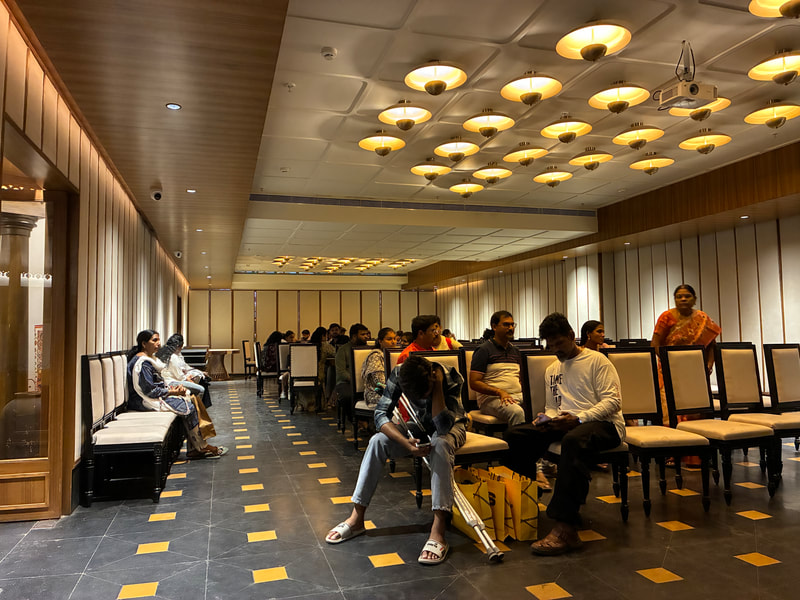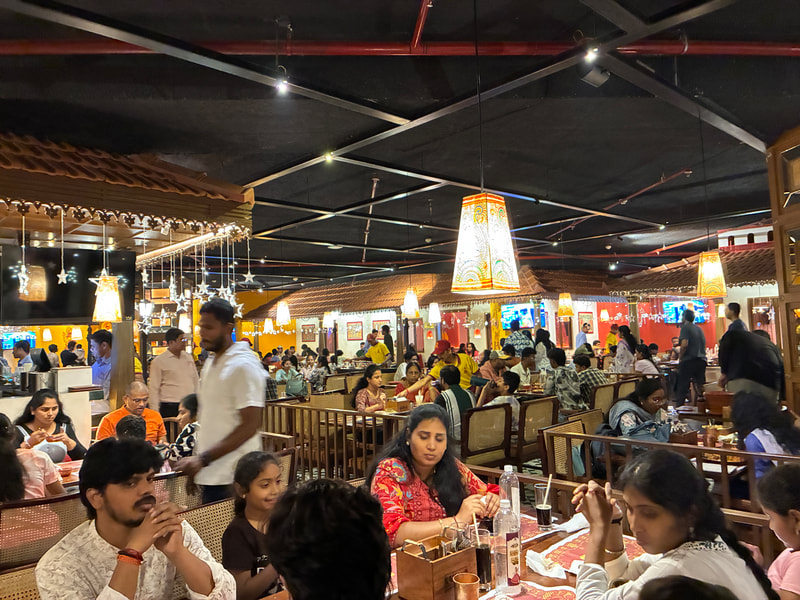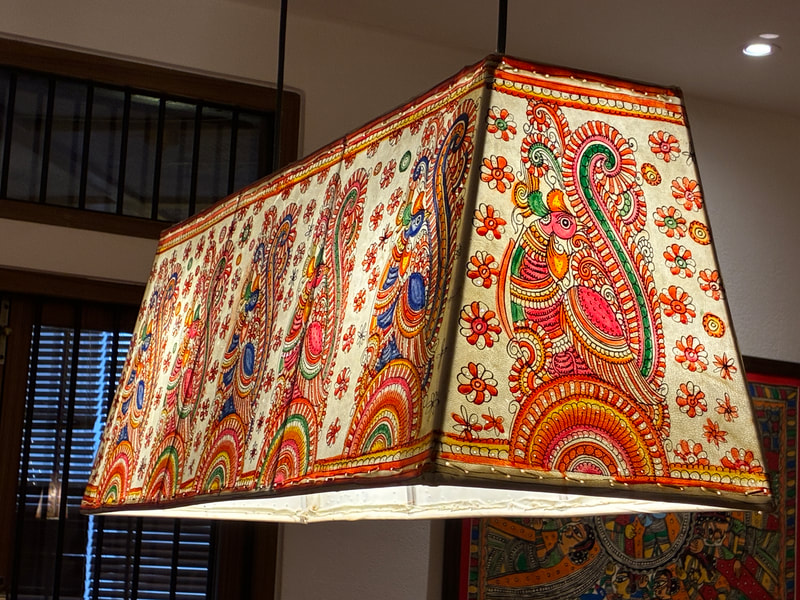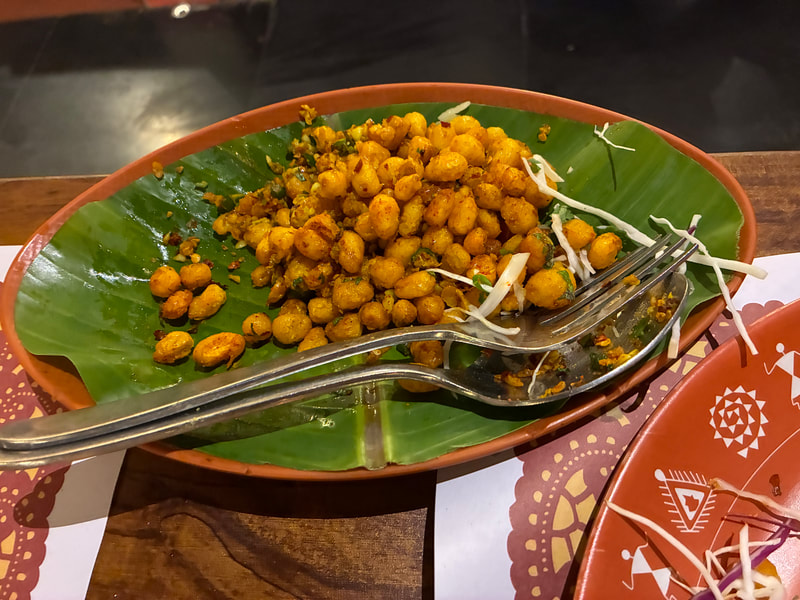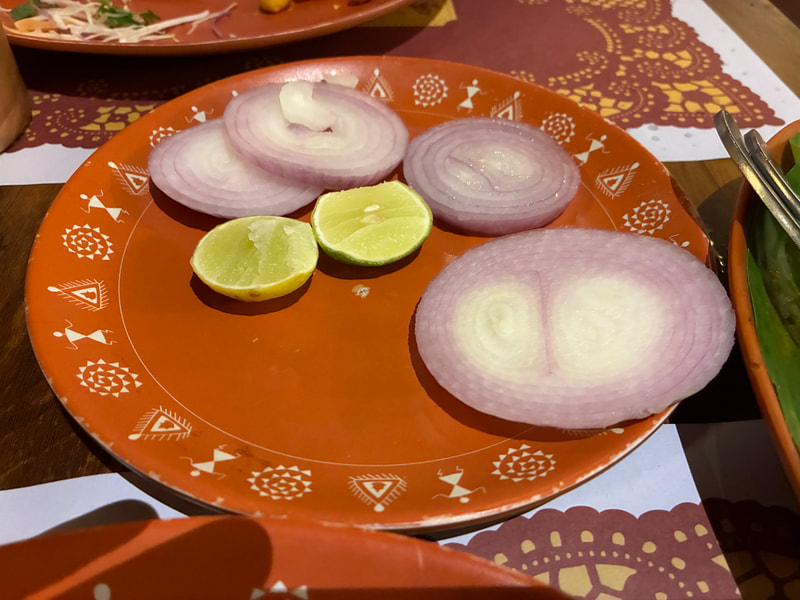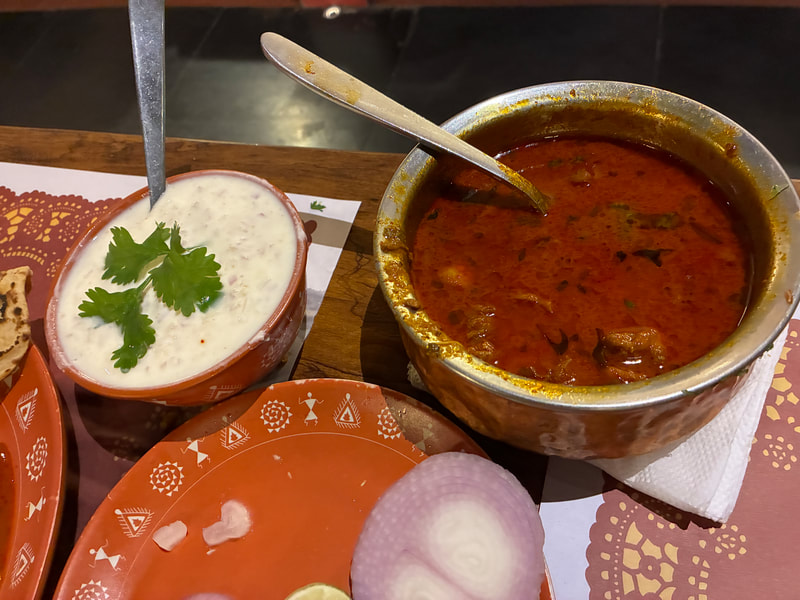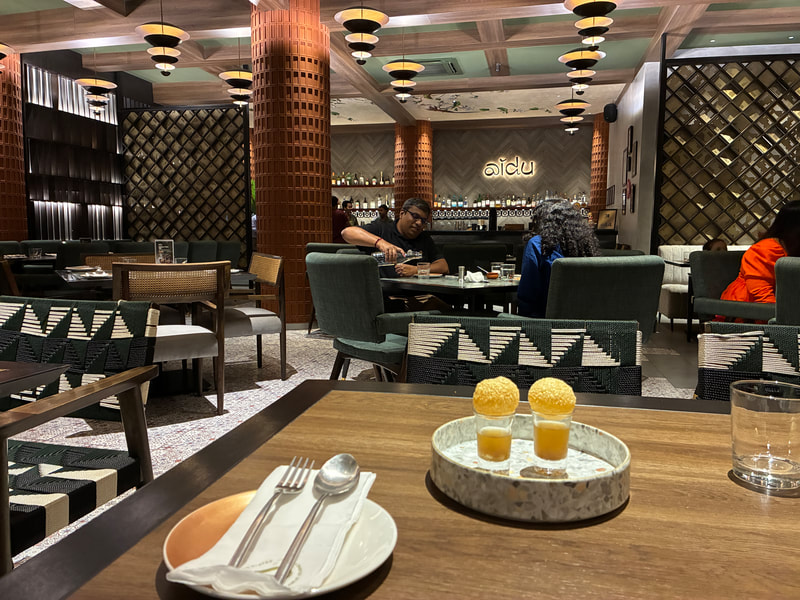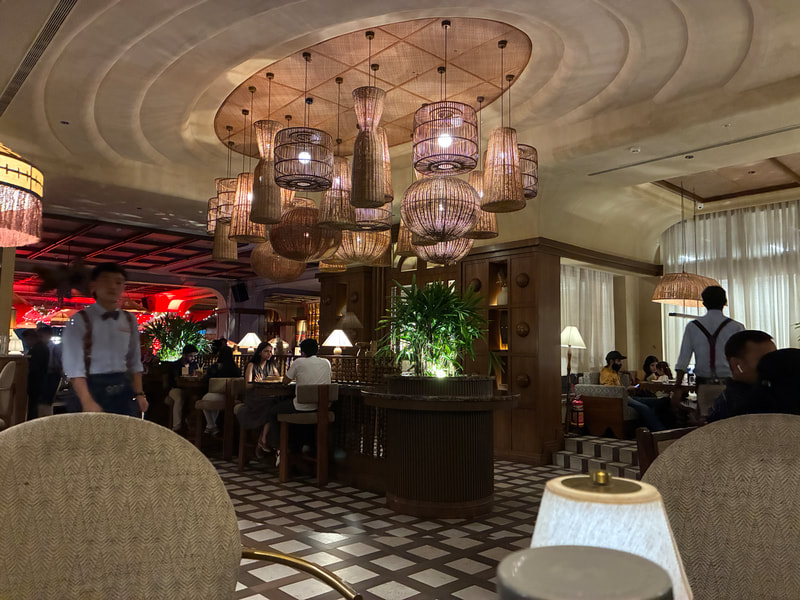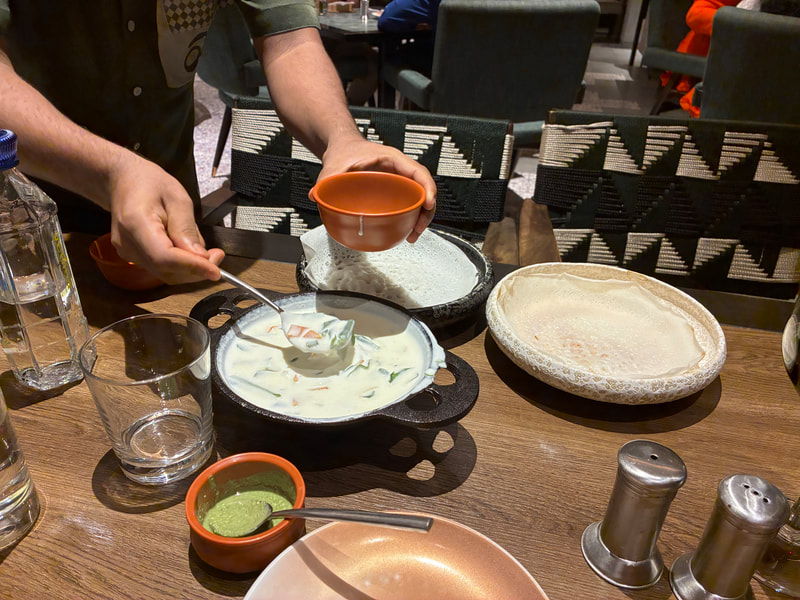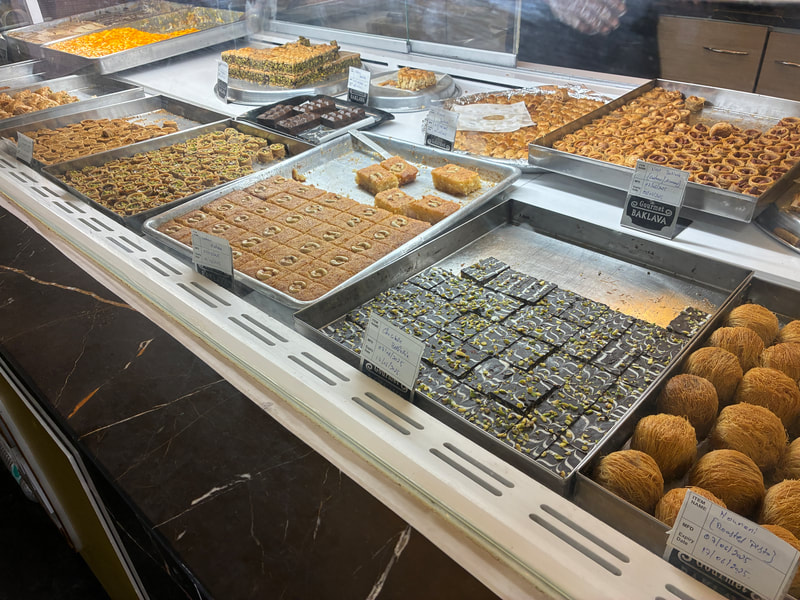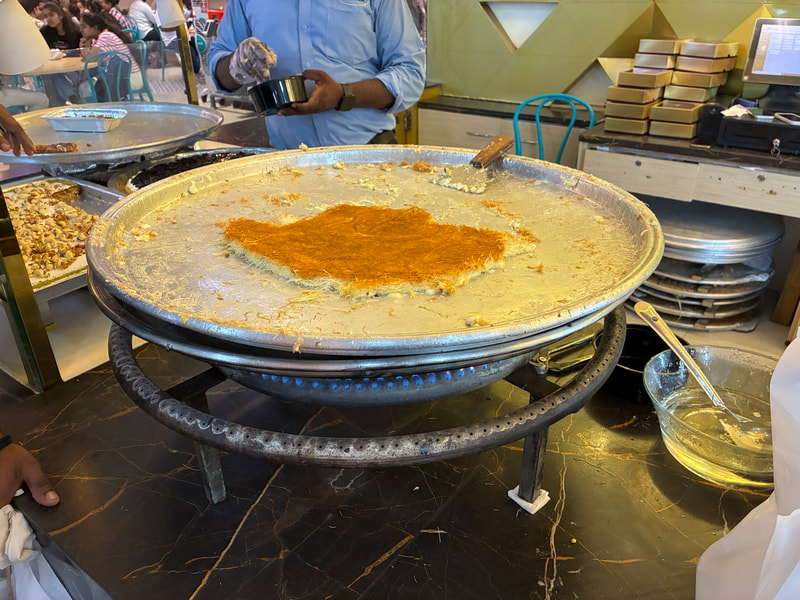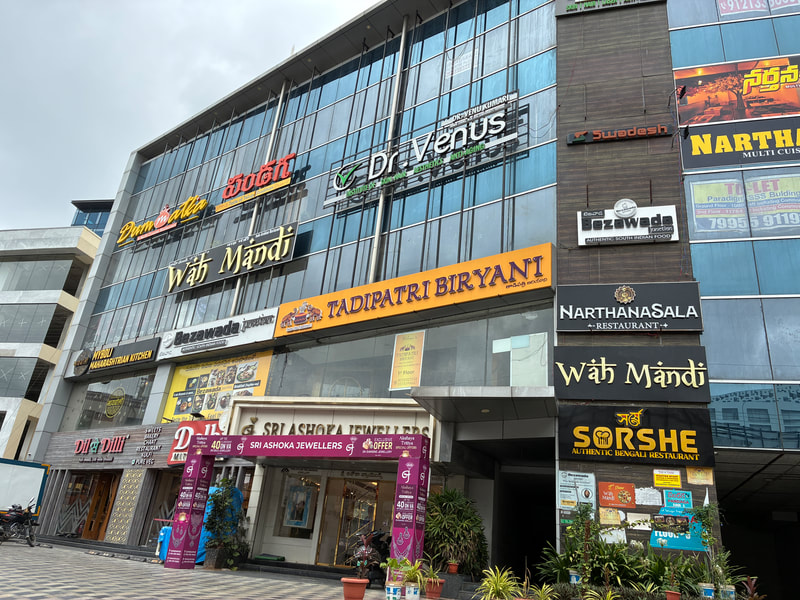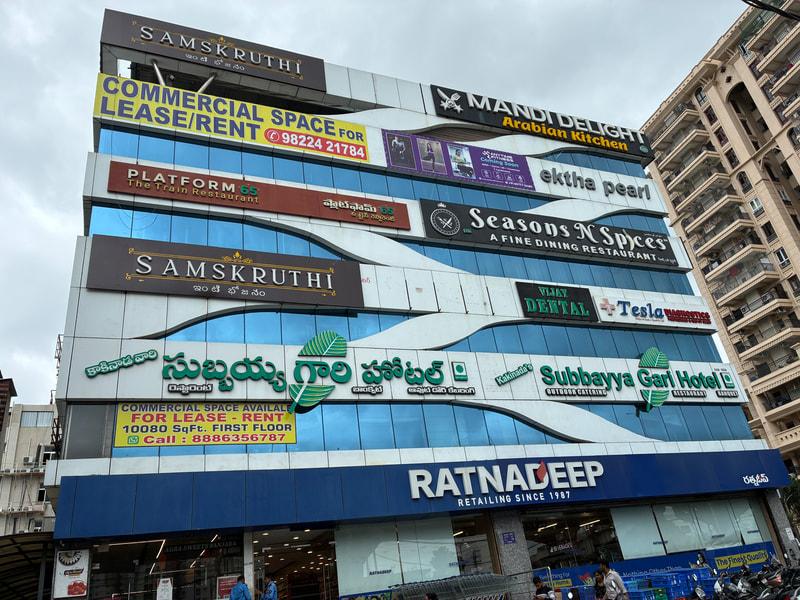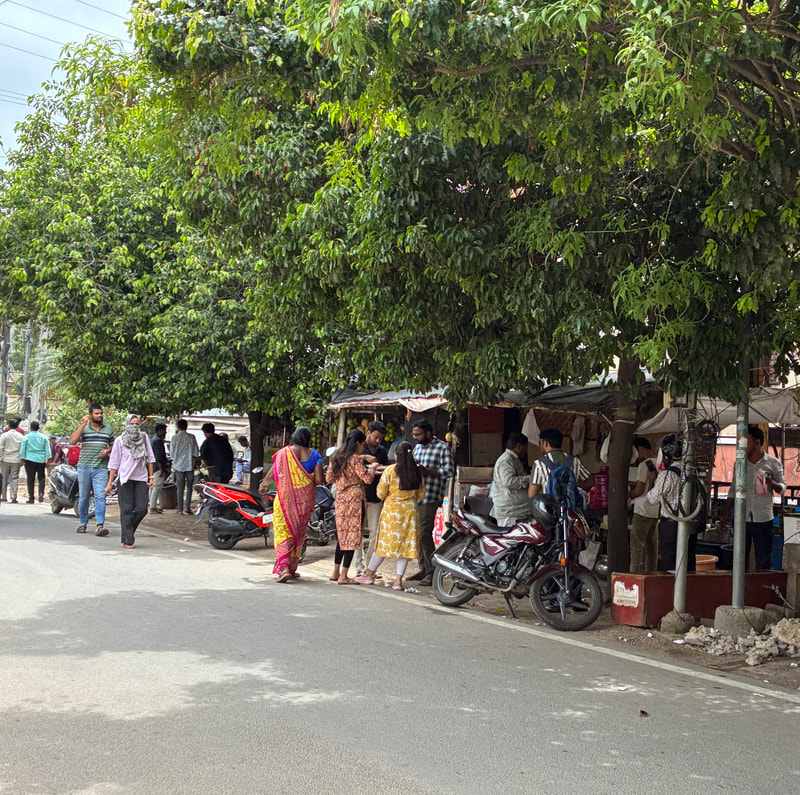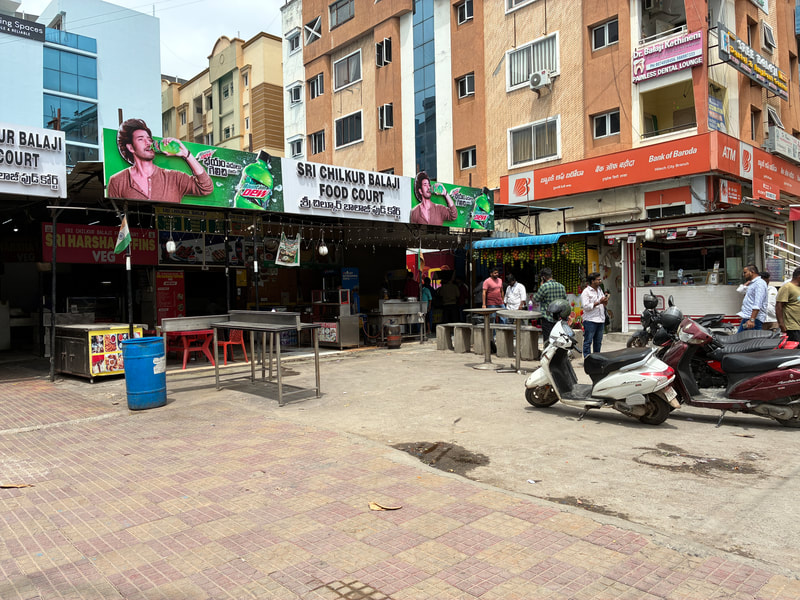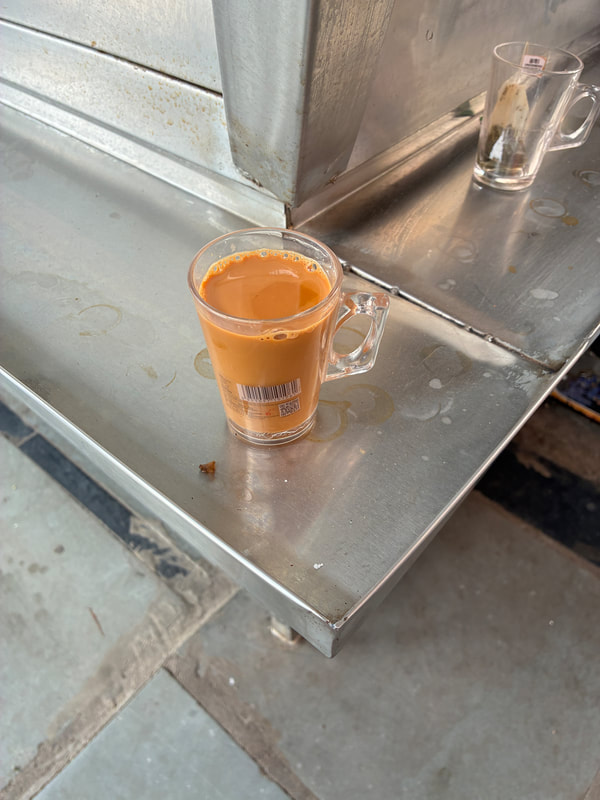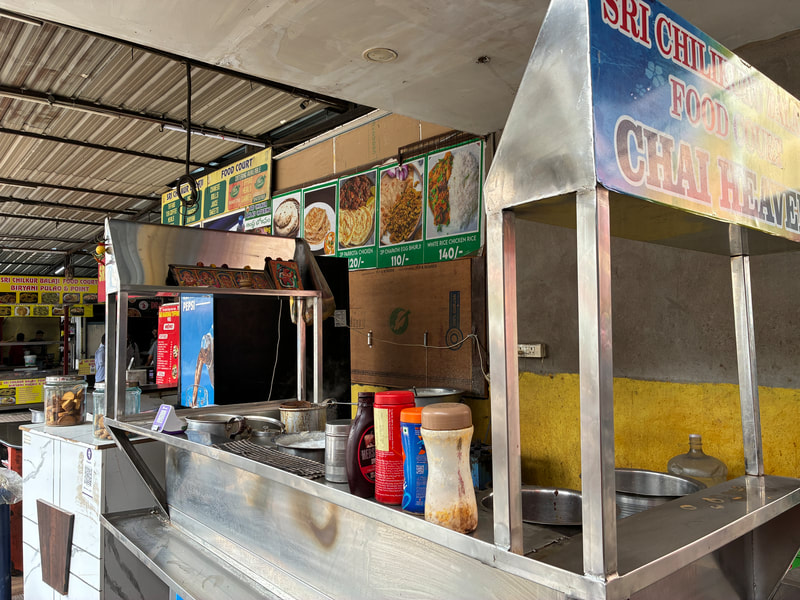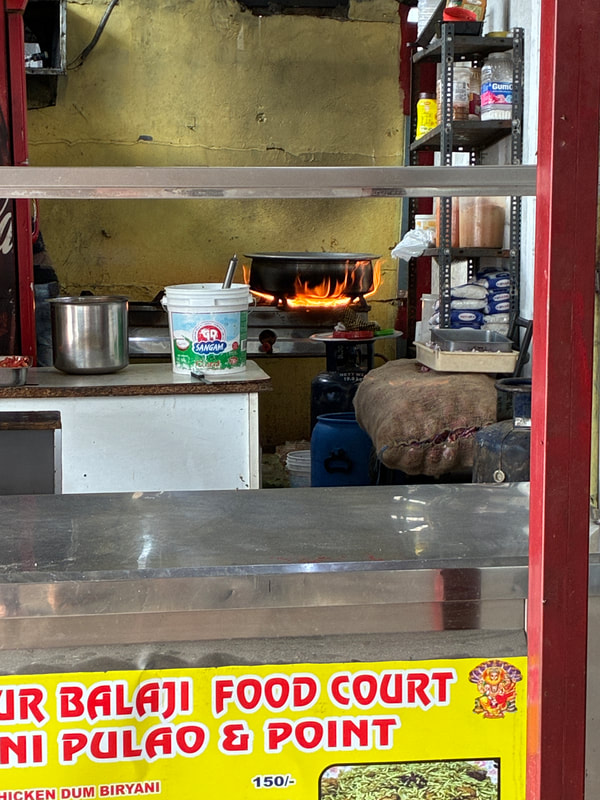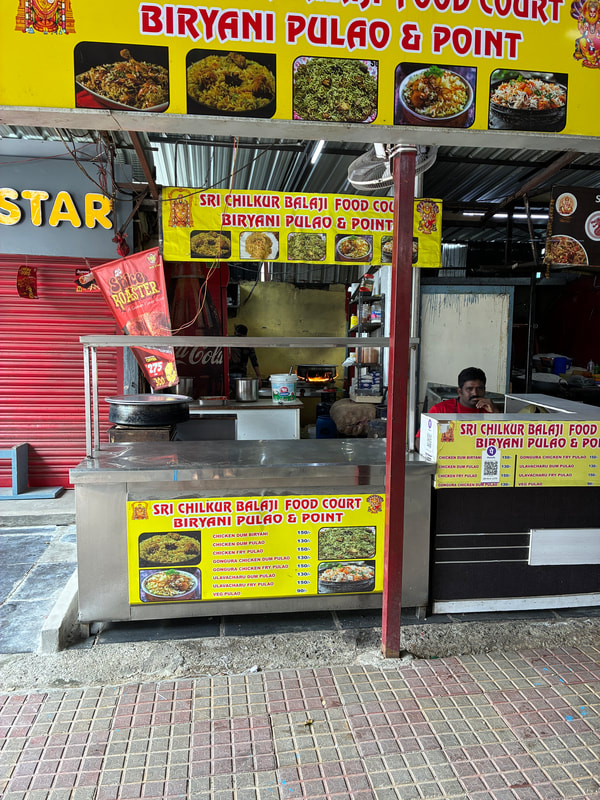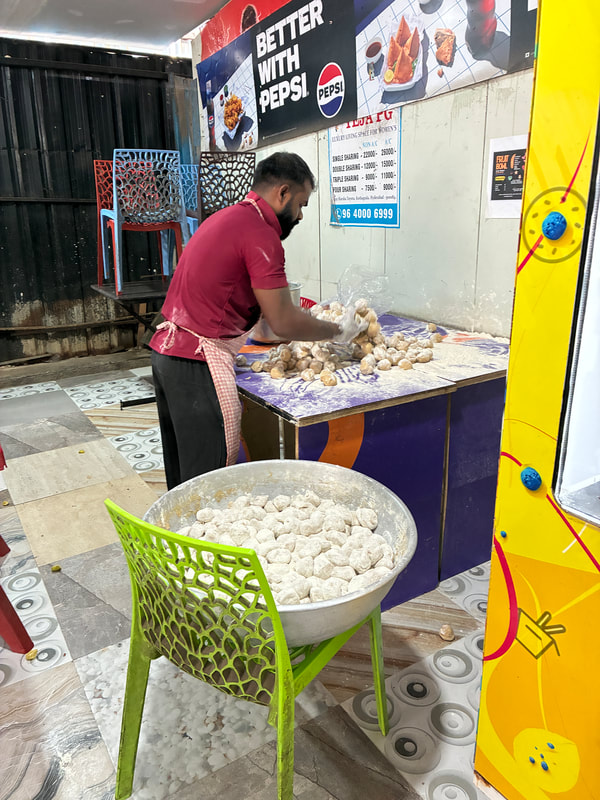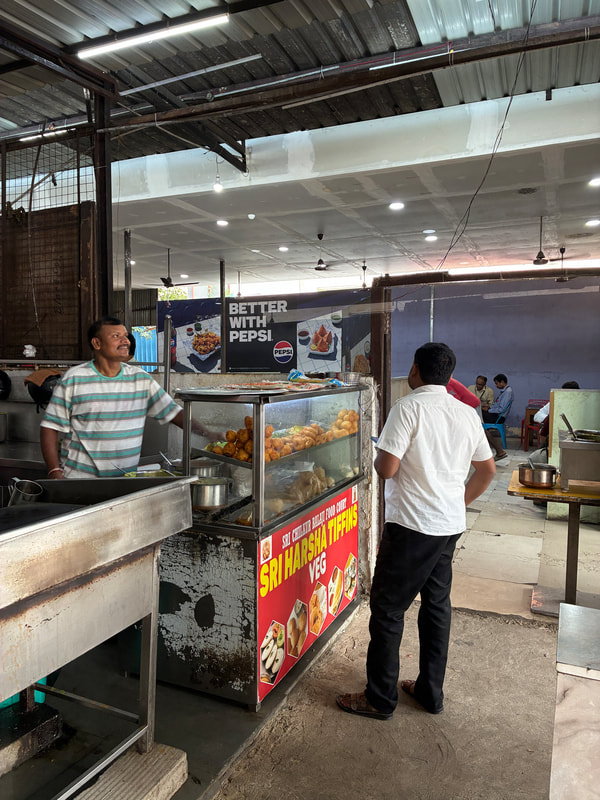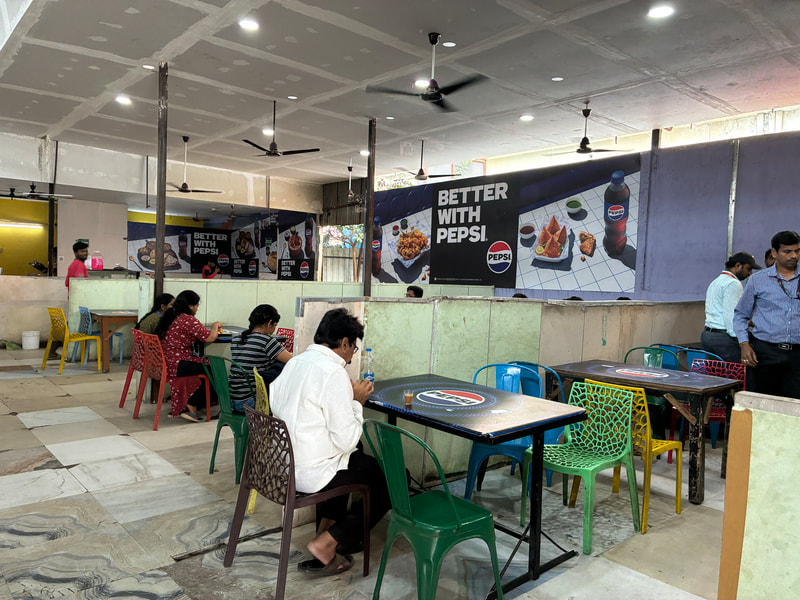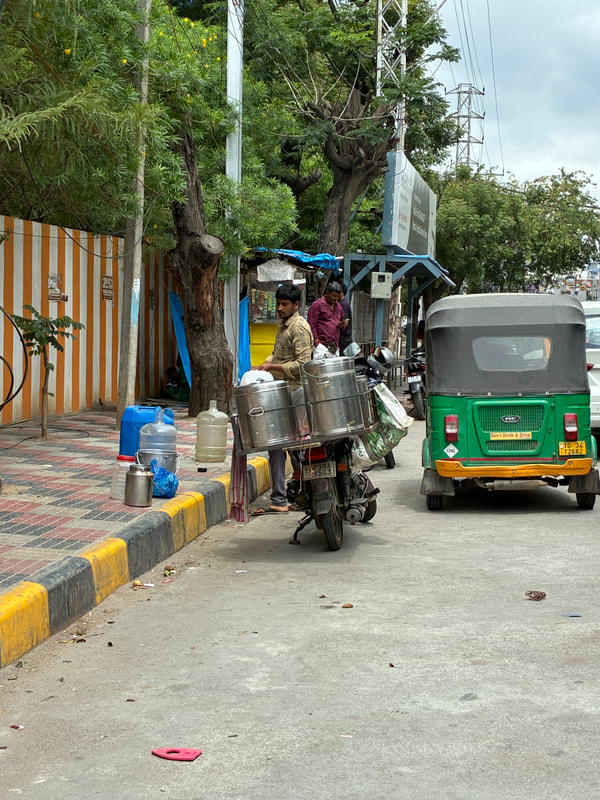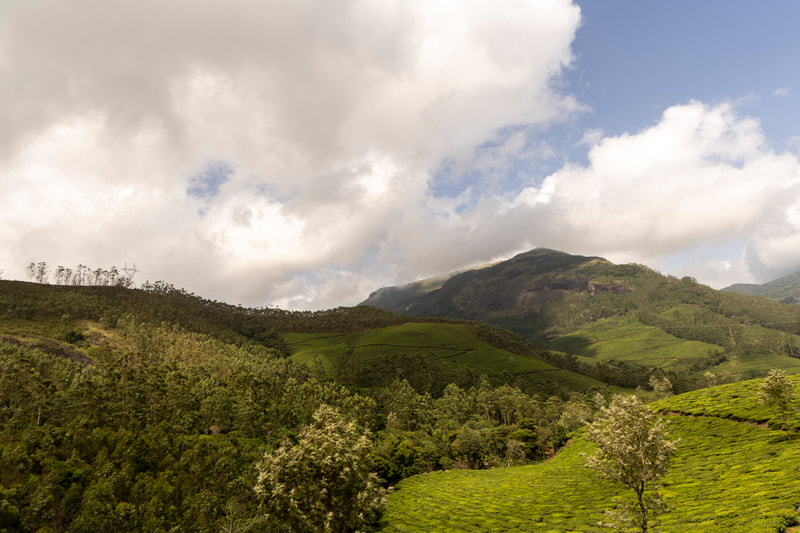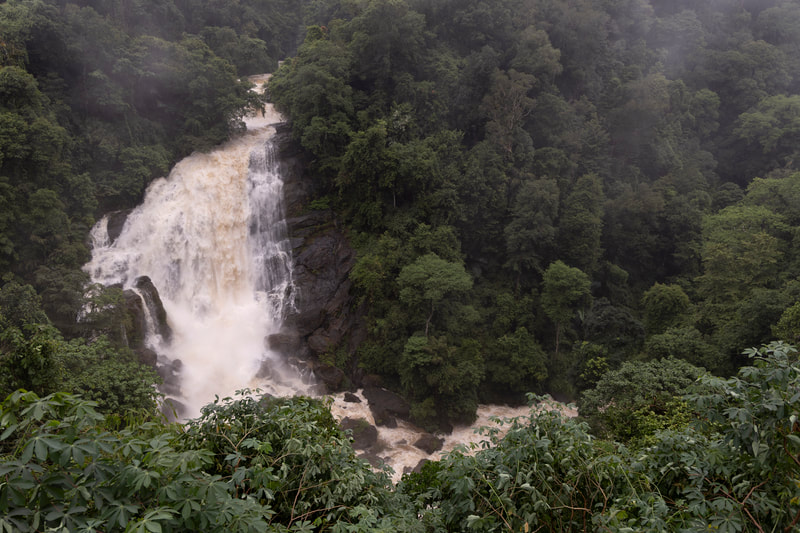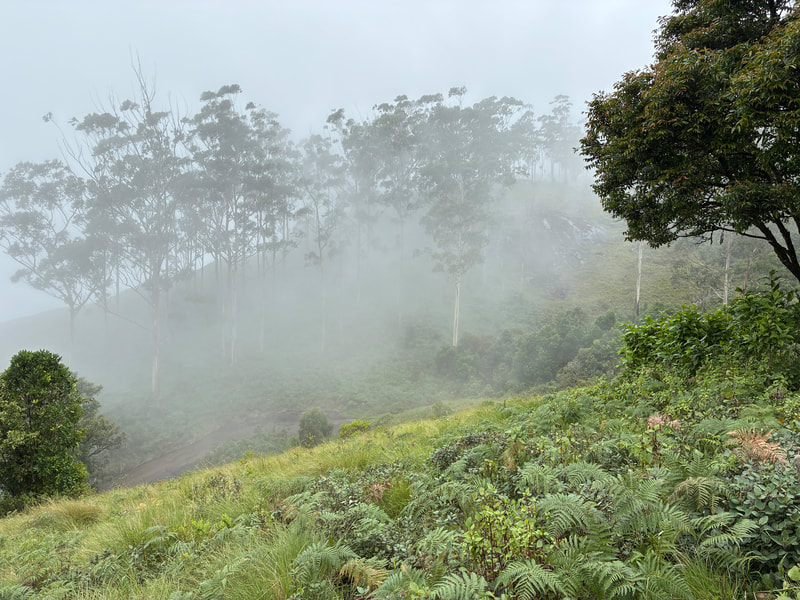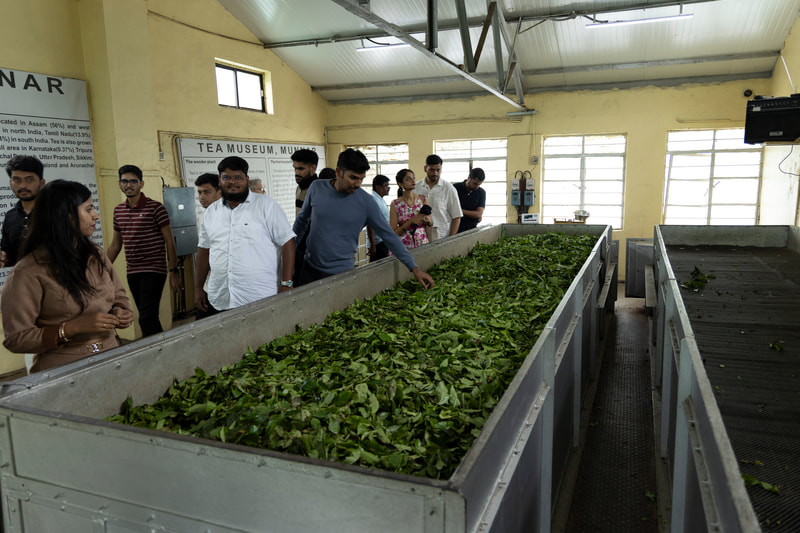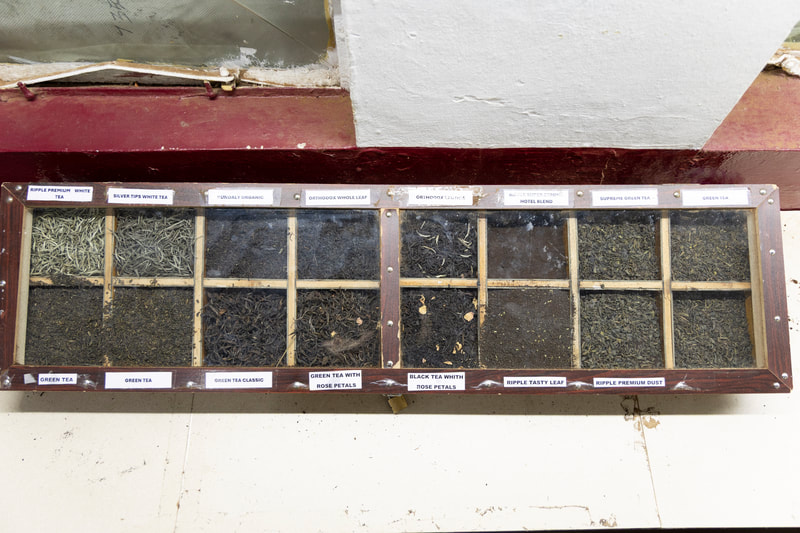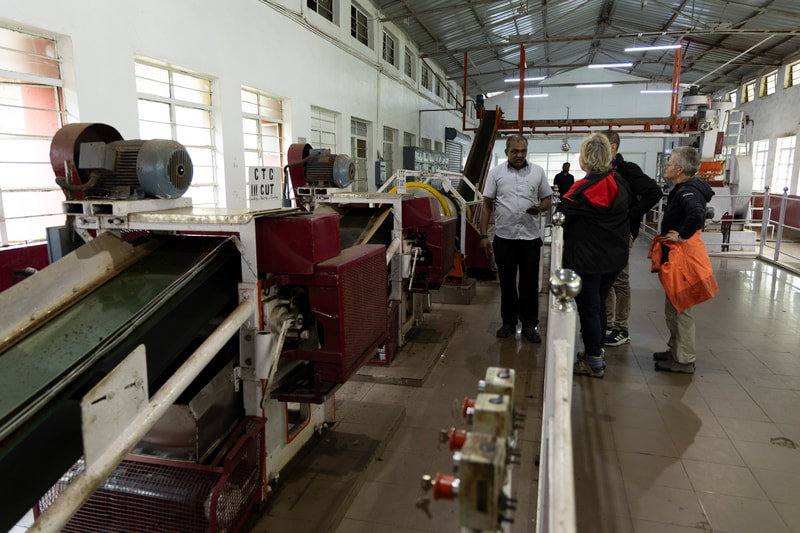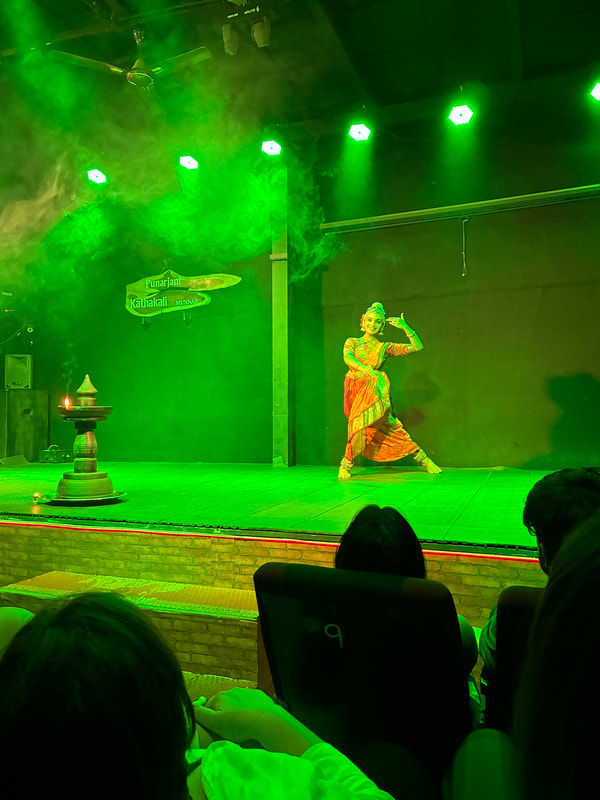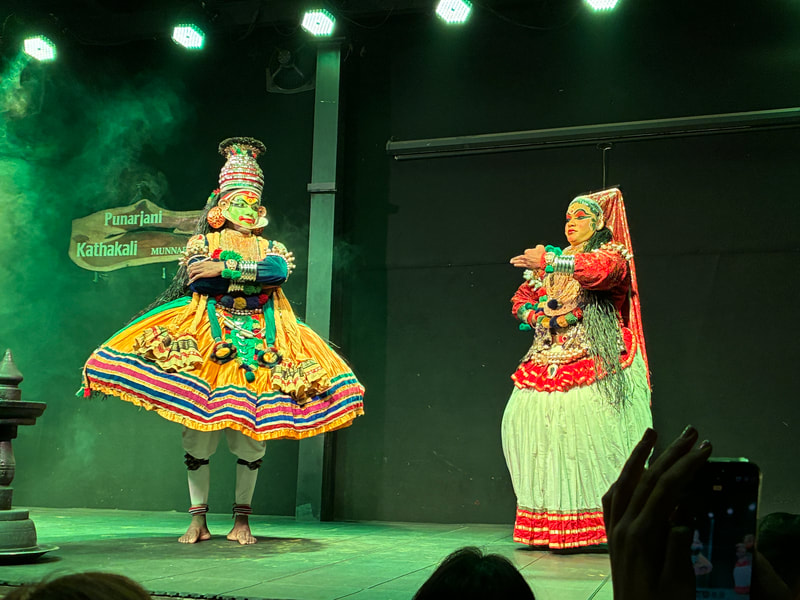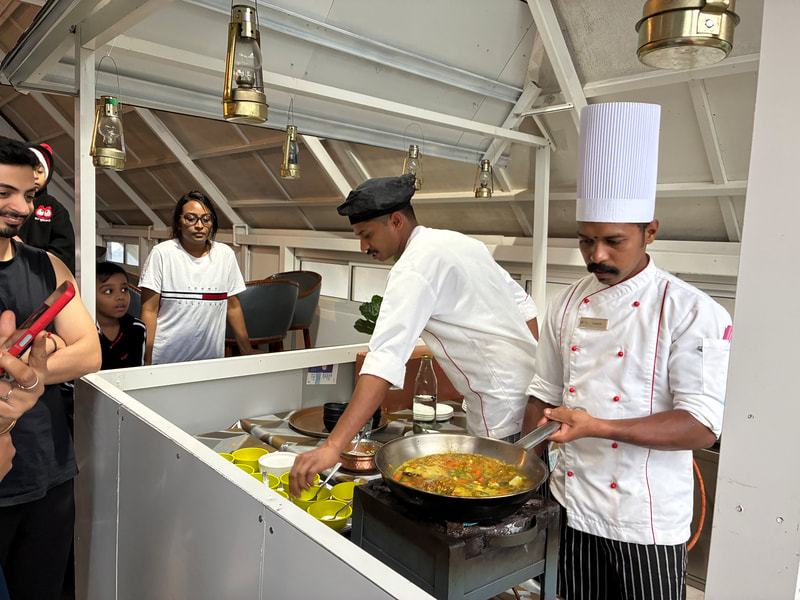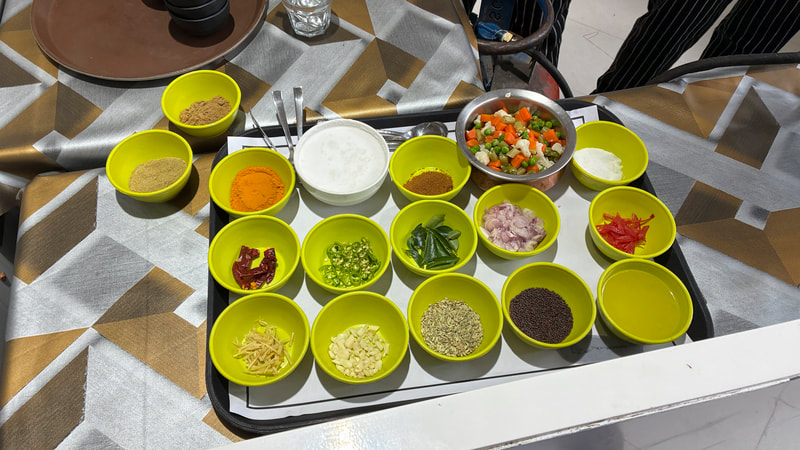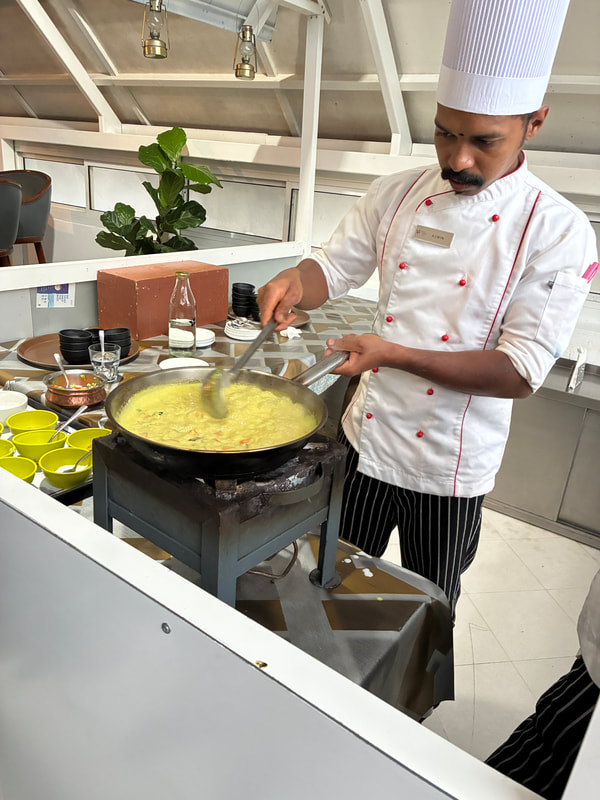|
Am Samstag waren wir im Zoo. Das war eine Entdeckung: er ist grosszügig ausgelegt und sehr grün. Die vielen grossen Bäume geben Schatten und durch die Grösse verteilen sich die Menschenmengen ganz gut. Die Tierkäfige bieten gefühlt etwa der Hälfte der Tiere genug Platz, andere sind nicht so grosszügig. Wir haben auch die eine oder andere Wildkatze mit dem typischen Zoogebahren (hin und her laufen) gesehen. Allerdings gibt es auch viele, die sich so verhalten, wie ich es in der Natur erwarten würde. Einige der Tiere habe ich zuvor nie in echt gesehen: Serval, Strauss, Pelikan, Hyäne, etc.. Sehr schön war, dass unser Fahrer seine (18 jährige) Tochter mitgebracht hat und die beiden mit uns den Zoo besucht haben. Foodrubrik: Wir haben zum ersten Mal "hot potatoes" gegessen. Dabei wird eine grosse Kartoffel spiralförmig geschnitten, auf einem Stab gespiesst und auseinandergezogen. Danach wird sie kurz in eine Sauce getaucht und im heissen Öl frittiert. Mit Salz und Gewürzen bestreut schmeckt das sehr gut 😋. Wir haben auch eine neue Zitrusfrucht entdeckt (nicht im Zoo), die Mosambi oder Sweet Lime, die jetzt saisonal angeboten wird. Sie ist sehr fein im Geschmack und ich finde, dass der Begriff süsse Limette gut passt. Am liebsten mögen wir sie als Saft. We went to the zoo on Saturday. It was a discovery: it is spacious and very green. The many large trees provide shade and the size means that the crowds are well distributed. The animal cages seem to offer enough space for about half of the animals, others are not so spacious. We also saw one or two wild cats with the typical zoo behaviour (running back and forth). However, there are also many that behave as I would expect in the wild. I have never seen some of the animals in real life before: Serval, ostrich, pelican, hyena, etc.... On a side note: Our driver brought his (18-year-old) daughter with him and the two of them visited the zoo with us. Great! Food section: We ate "hot potatoes" for the first time. A large potato is cut into a spiral, skewered on a stick and pulled apart. It is then briefly dipped in a sauce and deep-fried in hot oil. Sprinkled with salt and spices, it tastes really good 😋. We also discovered a new citrus fruit (not at the zoo), the mosambi or sweet lime, which is now available seasonally. It has a very delicate flavour and I think the term sweet lime fits well. We like it best as a juice. Samedi, nous sommes allés au zoo. Ce fut une découverte : il est spacieux et très vert. Les nombreux grands arbres donnent de l'ombre et la taille permet de bien répartir la foule. Les cages des animaux offrent suffisamment de place à la moitié d'entre eux, d'autres ne sont pas aussi spacieuses. Nous avons également vu l'un ou l'autre chat sauvage avec les manières typiques d'un zoo (courir dans tous les sens). Cependant, il y en a aussi beaucoup qui se comportent comme je m'y attendrais dans la nature. Je n'avais jamais vu certains animaux en vrai auparavant : Serval, autruche, pélican, hyène, etc. Par ailleurs, notre chauffeur a amené sa fille (18 ans) avec lui et les deux ont visité le zoo avec nous. C'est génial ! Rubrique nourriture :
Nous avons mangé pour la première fois des "hot potatoes". Il s'agit de couper une grosse pomme de terre en spirale, de l'embrocher sur un bâton et de l'écarter. Elle est ensuite trempée brièvement dans une sauce et frite dans l'huile chaude. Saupoudrée de sel et d'épices, c'est très bon 😋. Nous avons également découvert un nouvel agrume (pas au zoo), le mosambi ou sweet lime, qui est maintenant proposé en saison. Son goût est très fin et je trouve que le terme de citron vert doux lui convient bien. C'est en jus que nous le préférons.
1 Comment
Hier in Hyderabad gibt es eine Alliance Française und ein Goethe-Zentrum. Beide Institute bieten Sprachkurse an und organisieren Kulturanlässe. In den letzten Tagen haben sie gemeinsam, mit Hilfe von anderen musikalischen Organisationen, die "World Music Days" veranstaltet: In sieben Metrostationen wurde während vier Abenden jeweils von 17 - 19 Uhr Musik gespielt. Dazu gab's einen Eröffnungsabend in der grössten Metrostation und einen Abschlussabend mit Konzert in einem Club. Da ich den Mut nicht hatte, mich als Cellistin für den Anlass zu melden, habe ich mich als Freiwillige engagiert und hatte an jedem Abend in derselben Haltestelle Einsatz. Ich habe viele Amateur-MusikerInnen, Kinder und ein paar Profis gehört. Meine Aufgaben waren nicht sehr anstrengend und doch wichtig. Wir waren jeweils zu zweit dort: eine Frau, die in der Alliance Française für Kultur und Kommunikation zuständig ist und ich. Sie war für den ganzen Anlass mitverantwortlich und hatte viel mehr zu tun als ich. Wir haben uns sehr gut verstanden. Für mich ist fantastisch, dass ich durch dieses Event interessante Menschen kennengelernt habe: die Leiterinnen der beiden genannten Institute, Musikerinnen und Musiker, Menschen, die das Kulturleben hier mitgestalten. Alle Begegnungen waren warmherzig und offen, es haben und werden sich neue Möglichkeiten ergeben, wie ich mich hier (mit meinem Cello) einbringen kann. Es bleibt spannend 😁. There are an Alliance Française and a Goethe Centre here in Hyderabad. Both institutes offer language courses and organise cultural events. In the last few days, they have jointly organised the ‘World Music Days’ with the help of other musical organisations: Music was played in seven metro stations during four evenings from 5 - 7 pm. There was an opening evening in the largest metro station and a closing evening with a concert in a club. As I didn't have the courage to sign up as a cellist for the event, I volunteered and helped in the same station every evening. I heard lots of amateur musicians, children and a few professionals. My tasks were not very strenuous and yet important. There were always two of us there: a woman who is responsible for culture and communication at the Alliance Française and me. She was jointly responsible for the whole event and had a lot more to do than I did. We got on very well. For me, it's fantastic that I got to know interesting people through this event: the directors of the two institutes I mentioned, musicians, people who shape cultural life here. All encounters were warm-hearted and open, and new opportunities have arisen and will arise as to how I can get involved here (with my cello). Life here remains fascinating 😁. Ici, à Hyderabad, il y a un institut de l'Alliance française et un Goethe-Zentrum. Les deux instituts proposent des cours de langue et organisent des événements culturels. Ces derniers jours, ils ont organisé ensemble, avec l'aide d'autres organisations musicales, les « World Music Days » : Dans sept stations de métro, de la musique a été jouée pendant quatre soirs de 17 à 19 heures. De plus, il y a eu une soirée d'ouverture dans la plus grande station de métro et une soirée de clôture avec un concert dans un club.
Comme je n'ai pas eu le courage de m'inscrire à l'événement en tant que violoncelliste, je me suis engagée comme bénévole et j'ai aidé à ce que tout fonctionne chaque soir dans la même station. J'ai entendu de nombreux musiciens et musiciennes amateurs, des enfants et quelques professionnels. Mes tâches n'étaient pas très fatigantes et pourtant elles étaient importantes. Nous étions deux à chaque fois : une femme responsable de la culture et de la communication à l'Alliance Française et moi-même. Elle était co-responsable de l'ensemble de l'événement et avait beaucoup plus de travail que moi. Nous nous sommes très bien entendues. Pour moi, ce qui est fantastique, c'est que cet événement m'a permis de rencontrer des personnes intéressantes : les directrices des deux instituts cités, des musiciens et musiciennes, des personnes qui contribuent à la vie culturelle ici. Toutes les rencontres ont été chaleureuses et ouvertes, de nouvelles possibilités se sont présentées et se présenteront pour que je puisse m'investir ici (avec mon violoncelle). Notre vie ici reste passionnante 😁. Our beloved Irani Chai, typical for Hyderabad 😋 Wir essen (und trinken) hier viel mehr auswärts als in der Schweiz. Das hat mehrere Gründe: es ist erschwinglich (auch top Restaurants), spannend (weil wir viel entdecken) und natürlich bequem. Es gibt unendlich viele Beizen, Street Food Ecken, Fast Foods und Restaurants. Die meisten bieten (eine spezifische) indische Küche an. Welche genau ist dann sehr variantenreich, was bei diesem grossen Subkontinent nicht erstaunt. Es gibt süd- und nordindische Küche, das ist mal die grobe Unterscheidung. Dazu kommen lokale Spezialitäten, zum Beispiel das Hyderabader Biryani, oder solche aus ganz anderen Regionen. Wir können typische Speisen aus Goa, Westbengal, Punjab oder aus irgend einem anderen indischen Ort finden. Auch gibt es viele rein vegetarische Restaurants ("pure veg"); das bedeutet dann auch ohne Ei. Natürlich haben wir schon viel probiert, aber wir sind noch lange nicht am Ende der Entdeckungen! Zusätzlich findet man hier Restaurants mit "ausländischem" Essen: pan-asiatisch zum Beispiel, japanisch, italienisch, etc.. Es gibt dabei einige gute, allerdings finden wir relativ oft, dass der Geschmack nicht so ist, wie wir erwarten. Inzwischen haben wir auch hier Entdeckungen gemacht: am spannendsten bis anhin ist ein ausgezeichnetes burmesisches (rein vegetarisch) Restaurant. Da gibt es Speisen, die ich vorher noch nie probiert habe. Im (indischen) Restaurant gilt, dass die Speisen mit allen am Tisch geteilt werden. Wenn man das nicht möchte, muss man es sagen. Ausserdem wird man immer bedient, zumindest wenn das Essen gebracht wird. Die Portionen sind oft sehr gross und werden in Schalen oder auf Platten serviert, die auf dem Tisch bleiben. Die Mengen, die auf den Teller geschöpft werden, sind eher klein. Man isst oft mit dem Löffel oder mit der rechten Hand - ja, wir auch 😉. Wer mit der Hand isst, kann die Zutaten sehr gut mischen, und es gibt einem eine zusätzliche taktile Erfahrung. Das gilt für Reisgerichte oder wenn man ein Gericht mit indischem (also flachem) Brot isst. Ich habe einen Moment gebraucht, aber jetzt esse ich gewisse Speisen sehr gern mit der Hand. Wir haben gelernt, nicht zu viel aufs Mal zu bestellen. Das hat mehrere Gründe: wir möchten nicht alles gleichzeitig bekommen, wir können so die Mengen besser einschätzen und das Timing beeinflussen. We eat (and drink) out much more here than in Switzerland. There are several reasons for this: it's affordable (including top restaurants), exciting (because we discover a lot) and of course convenient. There are countless pubs, street food corners, fast food outlets and restaurants. Most of them offer (a specific) Indian cuisine. Which one exactly is very varied, which is not surprising for this large subcontinent. There is South and North Indian cuisine, that's the rough distinction. There are also local specialities, such as biryani from Hyderabad, or dishes from completely different regions. We can find typical dishes from Goa, West Bengal, Punjab or any other Indian place. There are also many purely vegetarian restaurants (‘pure veg’), which means without eggs. Of course, we have already tried a lot, but we are still far from the end of our discoveries! You can also find restaurants with ‘foreign’ food here: pan-Asian, for example, Japanese, Italian, etc.. There are some good ones, but we often find that the flavour is not what we expect. In the meantime, we have also made some discoveries here: the most exciting so far is an excellent Burmese (purely vegetarian) restaurant. There are dishes there that I have never tried before. In (Indian) restaurants, food is shared with everyone at the table. If you don't want this, you have to say so. In addition, you are always served, at least when the food is brought. The portions are often very large and are served in bowls or on plates that remain on the table. The quantities that are scooped onto the plate are rather small. People often eat with a spoon or with their right hand - yes, we do too 😉. Eating by hand allows you to mix the ingredients very well and gives you an additional tactile experience. This applies to rice dishes or when eating a dish with Indian (i.e. flat) bread. It took me a moment, but now I really enjoy eating certain dishes by hand. We have learnt not to order too much at once. There are several reasons for this: we don't want to get everything at the same time, we can better estimate the quantities and influence the timing. Translated with DeepL.com (free version) En bas: deux restaurants élégants - et on nous sert donc toujours la nourriture à la table. Nous mangeons (et buvons) beaucoup plus à l'extérieur ici qu'en Suisse. Il y a plusieurs raisons à cela : c'est abordable (même les meilleurs restaurants), passionnant (parce que nous découvrons beaucoup de choses) et bien sûr pratique. Il y a un nombre infini de bistrots, de coins de street food, de fast foods et de restaurants. La plupart d'entre eux proposent une cuisine indienne (spécifique). Laquelle est très variée, ce qui n'est pas étonnant pour ce grand sous-continent. Il y a la cuisine du sud et celle du nord de l'Inde, c'est la première distinction. S'y ajoutent des spécialités locales, par exemple le biryani d'Hyderabad, ou des plats d'autres régions. Nous pouvons trouver des plats typiques de Goa, du Bengale occidental, du Punjab ou de tout autre endroit indien. Il existe également de nombreux restaurants purement végétariens (« pure veg »), ce qui signifie sans œufs. Bien sûr, nous avons déjà goûté beaucoup de choses, mais nous sommes loin d'être au bout de nos découvertes ! De plus, on trouve ici des restaurants proposant de la nourriture « étrangère » : pan-asiatique par exemple, japonaise, italienne, etc. Il y en a de bons, mais nous trouvons assez souvent que le goût n'est pas celui que nous attendions. Entre-temps, nous avons également fait des découvertes dans ce domaine : le plus passionnant jusqu'à présent est un excellent restaurant birman (entièrement végétarien). Il y a des plats que je n'avais jamais goûtés auparavant. Au restaurant (indien), la règle veut que les plats soient partagés avec tout le monde à table. Si on ne le souhaite pas, il faut le dire. En outre, on est toujours servi, du moins au moment où la nourriture est apportée à table. Les portions sont souvent très grandes et sont servies dans des bols ou sur des plats qui restent sur la table. Les quantités servies dans l'assiette sont plutôt petites. On mange souvent avec une cuillère ou avec la main droite - oui, nous aussi 😉. Quand on mange avec la main, on peut très bien mélanger les ingrédients et cela nous donne une expérience tactile supplémentaire. C'est le cas pour les plats de riz ou quand on mange un plat avec du pain indien (donc plat). Cela m'a pris un peu de temps, mais maintenant j'aime beaucoup manger certains plats avec la main.
Nous avons appris à ne pas commander trop de choses à la fois. Il y a plusieurs raisons à cela : nous ne voulons pas tout avoir en même temps, nous pouvons ainsi mieux évaluer les quantités et influencer le timing. Traduit avec DeepL.com (version gratuite) Letztes Wochenende waren wir in Munnar in Kerala. Yashi hat den Freitag frei genommen und am Montag war ein Feiertag, also hatten wir vier Tage Zeit. Ich habe lange gesucht, bis ich einen Ort gefunden habe, wo keine hochsommerlichen Temperaturen herrschen und den ich Lust hatte zu bereisen. Meine Wahl ist auf Munnar in Kerala gefallen (unser Sohn hat diesen Ort besucht und empfohlen). Als ich einem befreundeten Ehepaar davon erzählt habe, hat dieses sich kurzentschlossen entschieden mitzukommen. Munnar ist auf 1700 m Höhe, in Südindien. Der höchste indische Berg, der nicht im Himalaya ist, befindet sich dort. Es gibt auch viele Teeplantagen. Die Berglandschaft fühlt sich für uns relativ vertraut an, nicht extrem hoch und eher hügelig, sehr grün und in unserem Fall auch regnerisch (v.a. an unserem Anreisetag). Allerdings ist die Vegetation und die Fauna ganz anders, da wir uns in einem subtropischen Hochland befinden. Es fühlt sich für mich nach Regenwald an: üppiges, dunkles und dichtes Grün, Affen am Strassenrand, Bananenstauden und viele Kokospalmen. Wir waren im Teemuseum, wo wir nach unseren Erfahrungen in Darjeeling einiges wieder gehört, aber auch Neues dazu gelernt haben. Die Plantage, auf der dieses Museum steht, gehört inzwischen einem Teil der Mitarbeitenden (denjenigen, die dort gearbeitet haben, als die Tata-Gruppe die Plantage verkauft hat). Das bedeutet, dass sie wie eine Genossenschaft funktioniert - das hat uns sehr gefallen. Dann haben wir einen Nationalpark besucht und dort einen Spaziergang gemacht. Die Landschaft ist sehr schön und unsere Freunde waren super beeindruckt. Sie kommen aus Australien und haben noch nie so eine Berglandschaft gesehen. Ein paar Nilgiri Tahrs (sieht aus wie eine Art Steinbock, ist aber offenbar eher mit dem Schaf verwandt) haben sich gezeigt, eines hat uns sogar beschnuppert - wollte wohl etwas zu fressen. Abends haben wir noch je eine lokale Tanz- und eine Kampfkunstvorführung besucht. Das war interessant und sehr unterhaltsam, v.a. die Kampfkunst. Abgesehen von diesen Ausflügen haben wir unser wunderschönes Hotel ausgenützt und entspannt. Die An- und Abreise haben je einen Tag beansprucht, so haben wir doch einen Teil von Kerala sehen können. Foodrubrik: Zwei der Hotelköche haben uns gezeigt, wie sie eines der typischen lokalen Gerichte kochen: ein Malabar Gemüsecurry. In Kerala isst man etwas weniger scharf. Es werden Kokosöl und auch viel Kokosmilch benützt. Bei den Gewürzen ist mir aufgefallen, dass sie nicht Kümmel sondern Fenchelsamen genommen haben. Ich glaube, das ist das erste indische Rezept ohne Kümmel, das ich gesehen und gegessen habe 😂. Abgesehen davon, haben sie ca. 15 Gewürze in den Curry gemischt, wie immer in Indien; ein Teil wird angebraten, ein anderer später reingemischt. Das ergibt schon sehr unterschiedliche Geschmäcke. Auf jeden Fall hat uns das Gemüsecurry geschmeckt. Am nächsten Tag jedoch gab es einen Fisch-Malabar-Curry beim Buffet. Den habe ich sensationell gefunden. Die Sauce hatte wieder Kokosmilch, aber auch Zitronensaft. Diese Mischung funktioniert super gut mit Fisch 😋. Last weekend we were in Munnar in Kerala. Yashi took Friday off and Monday was a public holiday, so we had four days. I searched for a long time until I found a place that didn't have midsummer temperatures and that I felt like travelling to. My choice fell on Munnar in Kerala (our son had visited and recommended this place). When I told friend of ours about it, they decided to come with us. Munnar is at an altitude of 1700 metres in southern India. The highest Indian mountain that is not in the Himalayas is located there. There are also many tea plantations. The mountain landscape feels relatively familiar to us, not extremely high and rather hilly, very green and in our case also rainy (especially on our day of arrival). However, the vegetation and fauna are completely different, as we are in a subtropical highland. It feels like a rainforest to me: lush, dark and dense greenery, monkeys by the roadside, banana trees and lots of coconut palms. We went to the tea museum, where we learnt some new things as well as hearing some knowns after our experiences in Darjeeling. The plantation on which this museum is located is now owned by some of the employees (those who worked there when the Tata Group sold the plantation). This means that it works like a co-operative - we really liked that. Then we visited a national park and went for a walk there. The landscape is very beautiful and our friends were super impressed. They are from Australia and have never seen a mountain landscape like this before. A few Nilgiri tahrs (looks like a kind of ibex, but is apparently more related to sheep) showed themselves, one even sniffed at us - probably wanted something to eat. In the evening, we attended a local dance and a martial arts performance. It was interesting and very entertaining, especially the martial arts. Apart from these excursions, we made the most of our wonderful hotel and relaxed. Travelling to and from the hotel took a day each, so we were able to see a part of Kerala. Food section: Two of the hotel chefs showed us how they cook one of the typical local dishes: a Malabar vegetable curry. In Kerala, the food is a little less spicy. They use coconut oil and a lot of coconut milk. When it came to spices, I noticed that they didn't use cumin but fennel seeds. I think this is the first Indian recipe without cumin that I have seen and eaten 😂. Apart from that, they mixed about 15 spices into the curry, as they always do in India; one part is fried, another is mixed in later. This results in very various flavours. In any case, we enjoyed the vegetable curry. The next day, however, we had a fish Malabar curry at the buffet. I found it sensational. The sauce had coconut milk again, but also lemon juice. This mixture works really well with fish 😋. Le week-end dernier, nous sommes allés à Munnar, dans le Kerala. Yashi a pris congé le vendredi et le lundi était un jour férié, nous avons donc eu quatre jours de congés. J'ai cherché longtemps avant de trouver un endroit où les températures ne sont pas super chaudes et que j'avais envie de visiter. Mon choix s'est porté sur Munnar, dans le Kerala, car c'est un endroit que notre fils avait visité et recommandé. Lorsque j'en ai parlé à un couple d'amis, ils ont décidé de se joindre à nous. Munnar se trouve à 1700 mètres d'altitude, dans le sud de l'Inde. La plus haute montagne indienne, qui ne se trouve pas dans l'Himalaya, s'y dresse. On y trouve également de nombreuses plantations de thé. Le paysage montagneux nous semble relativement familier, pas extrêmement raide, plutôt vallonné, très vert, et, dans notre cas, également pluvieux (surtout le jour de notre arrivée). Cependant, la végétation et la faune sont très différentes, car nous nous trouvons dans un haut-plateau subtropical. On dirait une forêt tropicale : une verdure luxuriante, sombre et dense, des singes au bord de la route, des bananiers et beaucoup de cocotiers.
Nous sommes allés au musée du thé, où nous avons réentendu certaines choses après notre expérience à Darjeeling, mais où nous avons aussi appris de nouvelles choses. La plantation sur laquelle se trouve ce musée appartient désormais à une partie des collaborateurs (ceux qui y travaillaient lorsque le groupe Tata a vendu la plantation). Cela signifie qu'elle fonctionne comme une coopérative - ce qui nous a beaucoup plu. Ensuite, nous avons visité un parc national et nous y avons fait une promenade. Le paysage est très beau et nos amis ont été super impressionnés. Ils viennent d'Australie et n'ont jamais vu un tel paysage de montagne. Quelques Nilgiri Tahrs (qui ressemblent à une sorte de bouquetin, mais qui sont apparemment plus proches du mouton) se sont montrés, l'un d'eux nous a même reniflés - il voulait sans doute quelque chose à manger. Le soir, nous avons assisté à une démonstration de danse locale et d'arts martiaux. C'était intéressant et très divertissant, surtout les arts martiaux. En dehors de ces excursions, nous avons profité de notre magnifique hôtel et nous nous sommes détendus. Le voyage aller et retour ont pris chacun une journée, ce qui nous a permis de voir une partie du Kerala. Rubrique bouffe : Deux des cuisiniers de l'hôtel nous ont montré comment ils cuisinent l'un des plats locaux typiques : un curry de légumes Malabar. Au Kerala, on mange un peu moins épicé. On utilise de l'huile de coco et beaucoup de lait de coco. Pour les épices, j'ai remarqué qu'ils n'ont pas utilisé de cumin mais des graines de fenouil. Je crois que c'est la première recette indienne sans cumin que j'ai vue et mangée 😂. À part ça, ils ont mélangé une quinzaine d'épices dans le curry, comme toujours en Inde ; une partie est saisie, une autre est mélangée plus tard. Cela donne des goûts très différents. En tout cas, nous avons apprécié le curry. Le lendemain, le buffet proposait un curry de poisson malabar. Je l'ai trouvé sensationnel. La sauce contenait à nouveau du lait de coco, mais aussi du jus de citron. Ce mélange fonctionne super bien avec le poisson 😋. Traduit avec DeepL.com (version gratuite) |
About usWe are a couple in the mid-fifties and are going to live for two years in Hyderabad, India. Time in Hyderabad
Archives
November 2025
Categories |
